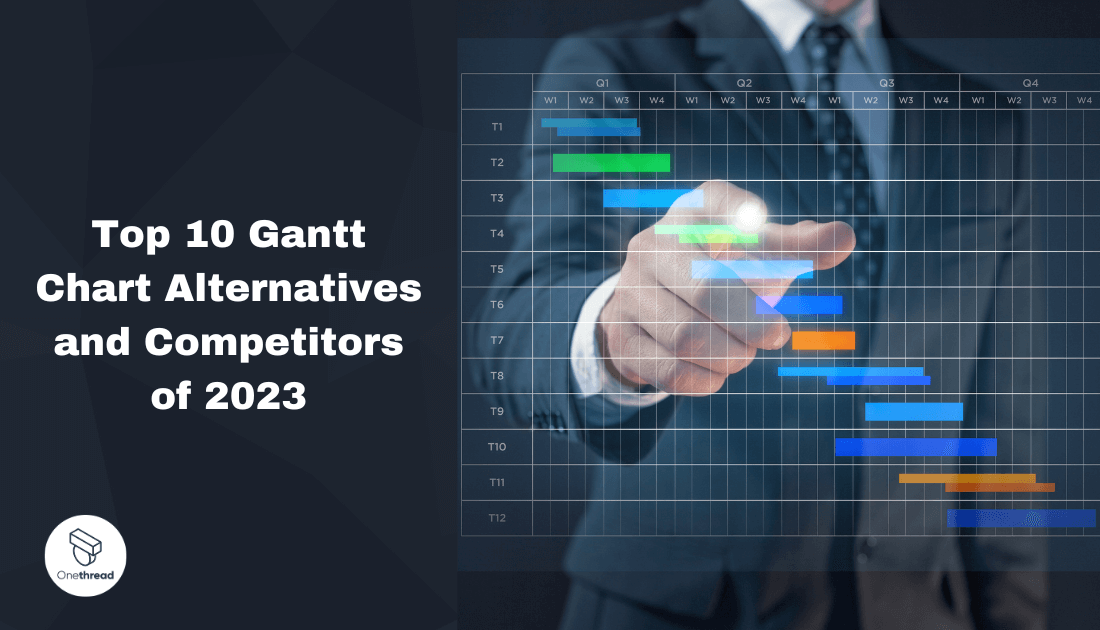Gantt Charts, once the revolutionary tool for visually tracking a project’s schedule, have found themselves under scrutiny in today’s dynamic project management environment.
While their utility in laying out the sequence of tasks is undisputed, modern project managers often seek more agile, user-friendly solutions that can adapt to the fast-paced changes in the business world.
Are you feeling the constraints of traditional Gantt Charts? Fear not; you’re not alone. In this comprehensive guide, we’ll explore the Top 10 Gantt Chart Alternatives and Competitors of 2023, unraveling the features and benefits that make these tools the go-to choices for project professionals aiming to take their project tracking to the next level.
Our reviewers evaluate software independently. Clicks may earn a commission, which supports testing. Learn how we stay transparent & our review methodology
Quicklist of Gantt Chart Alternatives
- Onethread: Offers a user-friendly interface, task tracking, Kanban board, Gantt chart, integration with popular tools, and a mobile app.
- Monday.com: Known for customizable workflows, visual project tracking, automation, collaboration tools, integration options, and time tracking.
- Kissflow: Provides process automation, workflow management, collaboration tools, integration capabilities, and customizable templates.
- Asana: Focuses on task and project management, customization options, collaboration features, timeline view, and integration choices.
- Trello: Offers visual task management with cards and lists structure, collaboration features, labels, filters, and a mobile app.
- Wrike: Specializes in task and project management, customizable workflows, Gantt charts, automation, collaboration tools, and time tracking.
- Smartsheet: Utilizes a spreadsheet-based approach for project management, including grid and card views, automation, collaboration and sharing, and integration options.
- ClickUp: Concentrates on task and project management, customizable views, time tracking, automation, collaboration tools, and a mobile app.
- Zoho Projects: Focuses on task and project management, and provides Gantt charts, time tracking, collaboration tools, and integration capabilities.
- Basecamp: Emphasizes communication in project management, and includes to-do lists, a calendar, message boards, file sharing, and collaboration tools.
Onethread – The Best Gantt Chart Alternative
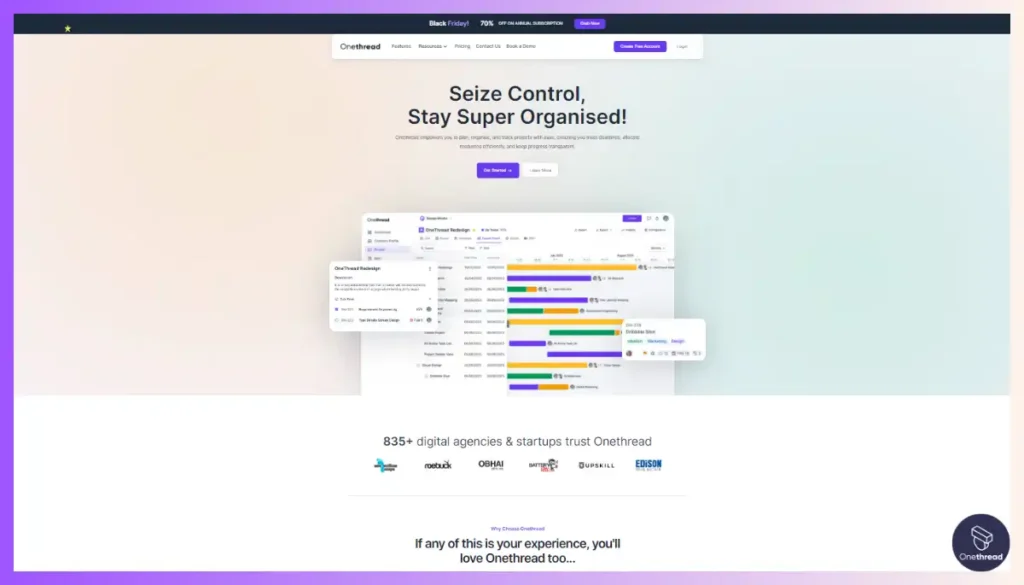
Bidding farewell to the rigid boundaries of traditional Gantt Charts, Onethread emerges as a dynamic and responsive project management tool. Tailored to cater to modern project needs, it offers an intuitive interface that goes beyond mere task scheduling.
Onethread enables real-time collaboration, streamlined workflow, and a level of adaptability that sets it apart as a powerful alternative to Gantt Charts.
Dynamic Task Management
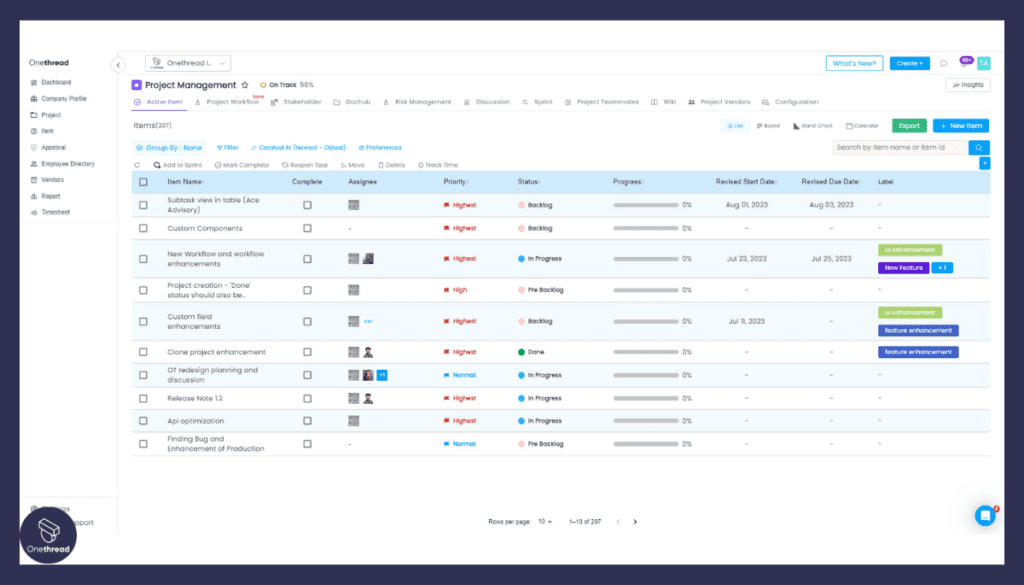
Onethread’s Dynamic Task Management enables changes and adjustments on the fly, allowing for real-time updates and adaptability.
Unlike static Gantt Charts, it accommodates changes without disrupting the whole project schedule, providing flexibility and responsiveness.
Intuitive Collaboration Platform
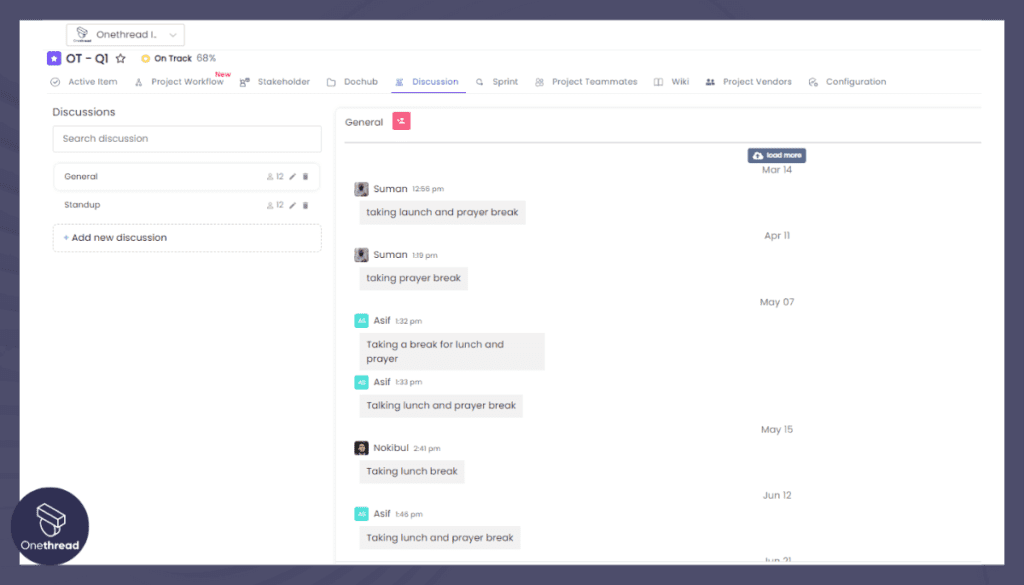
With an emphasis on collaboration, Onethread offers an Intuitive Collaboration Platform that fosters team communication and shared decision-making. It integrates chat, file sharing, and other tools to support seamless teamwork.
Streamlined Workflow Automation
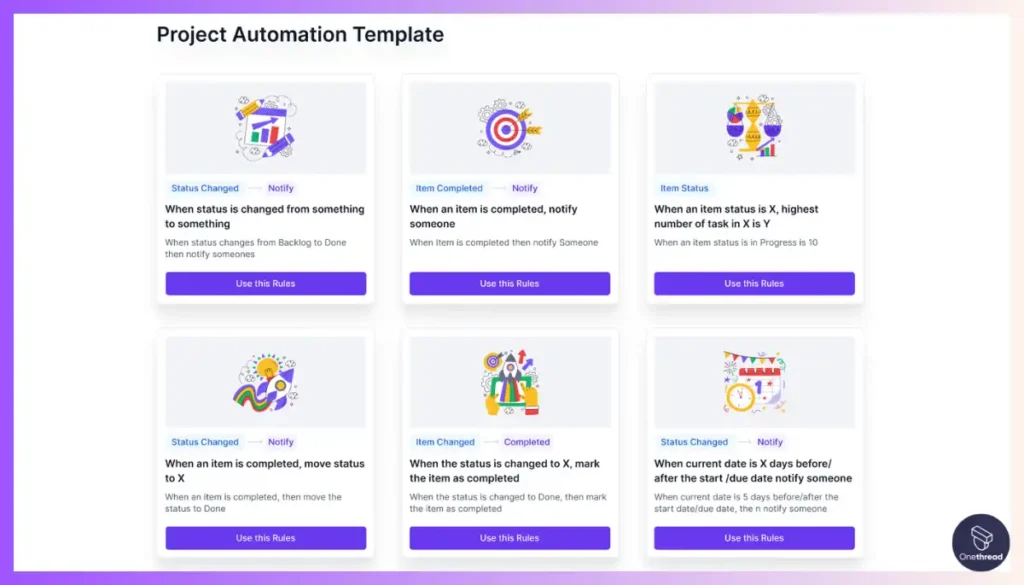
Onethread’s Streamlined Workflow Automation allows the creation of customized workflows that automate routine tasks and processes. This leads to increased efficiency, consistency, and frees up valuable time for more critical activities.
Interactive Visualization Tools
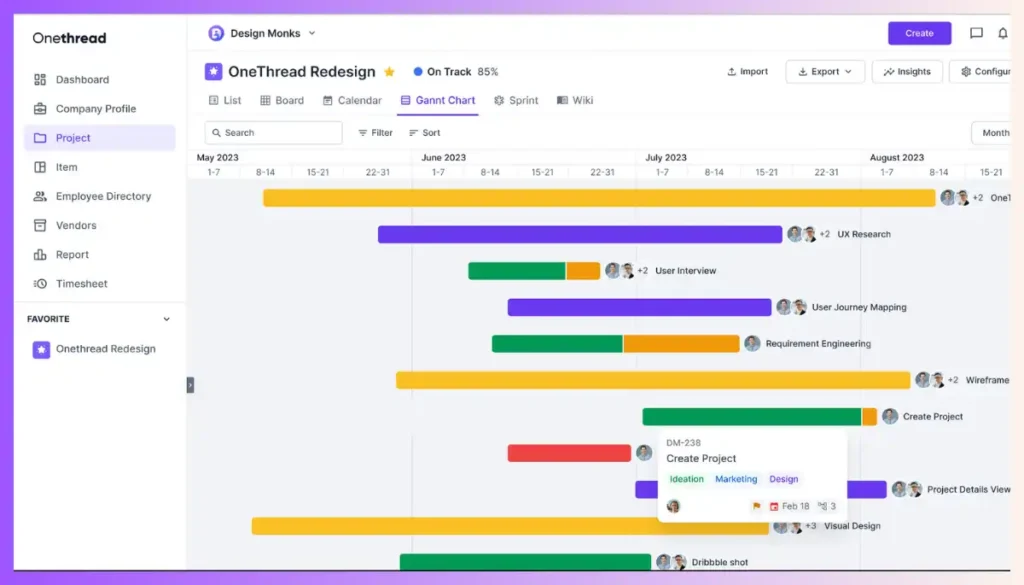
Going beyond traditional Gantt Charts, Onethread provides Interactive Visualization Tools that give a multi-dimensional view of the project.
Team members can visualize progress, dependencies, and potential bottlenecks, providing deeper insights into the project’s state.
Adaptive Resource Management
Onethread’s Adaptive Resource Management ensures optimal allocation and utilization of resources, such as personnel, equipment, and budget.
It offers tools for monitoring and adjusting resources in real-time, promoting effective project execution.
Onethread vs Gantt Chart: A Quick Comparison
Feature | Onethread | Gantt Chart |
Gantt chart | ✓ | ✓ |
Thread-based Task Management | ✓ | ✗ |
Discussion and wiki | ✓ | ✗ |
Real-Time Reporting | ✓ | ✓ |
Customizable Views | ✓ | ✓ |
Platforms
Onethread is available on Windows, macOS, Linux, iOS, Android, making it accessible across various devices and operating systems.
Pros & Cons of Onethread
Pros
- User-friendly interface
- Visual task management
- Integration with popular tools
Cons:
- Might have a difficult learning curve for some.
Pricing Plans

- Free
- Growth: $3.6/user/month
- Scale: $6/user/month
What Is Gantt Chart and Why Is It Used?
A Gantt Chart is a horizontal bar chart utilized extensively in project management to illustrate a project schedule. Originating in the late 19th century, it was popularized by Henry L. Gantt in the 1910s.
This visual tool helps project managers and team members to see the start and end dates of different tasks within a project. By providing a clear depiction of task sequences, durations, and completion dates, Gantt Charts have become an indispensable tool for ensuring projects stay on track.
Notable Features of Gantt Charts:
- Visual Timeline: Gantt charts provide a clear visual representation of a project’s timeline from start to finish, aiding in understanding project duration and deadlines.
- Task Dependencies: They display the relationship and sequence between tasks, helping in identifying which tasks must be completed before others can start.
- Progress Tracking: Gantt charts allow for tracking task completion levels, providing insights into the overall project’s status and potential delays.
- Resource Allocation: These charts indicate who is responsible for each task, promoting effective resource management and workload distribution.
- Milestones Highlighting: Gantt charts emphasize significant project milestones, ensuring key events or deadlines are easily recognized.
- Overlapping Task Visualization: They depict when multiple tasks are occurring concurrently, aiding in identifying potential resource conflicts or task overlaps.
Why Search for Gantt Chart Alternatives?
Even though Gantt Charts are foundational in project management, the modern-day demands have made professionals seek alternatives. The reasons for this shift include:
- Adaptability to Change: Traditional Gantt Charts can be rigid, making it challenging to adapt when changes in the project schedule occur.
- Complexity for Large Projects: When projects grow in size, Gantt Charts can become too intricate, making them hard to interpret.
- Real-time Collaboration Limitations: Gantt Charts aren’t always optimized for real-time updates and feedback from multiple team members.
- Overemphasis on Deadlines: A heavy focus on deadlines might overlook the quality or depth of task completion.
- Absence of Network Diagram Integration: While a Gantt Chart shows when tasks happen, it often lacks the network diagram feature to showcase how tasks are interrelated.
- Limited Interactivity: Modern project management tools offer more dynamic features like drag-and-drop, which traditional Gantt Charts might lack.
Pros and Cons of Gantt Chart
Pros
- Clear timeline visualization
- Task dependency tracking
- Resource allocation management
Cons:
- May lack advanced collaboration features
Feature Comparison of Top 10 Gantt Chart Competitors At a Glance
Tool | Task Management | Document Sharing | Customer Support Description | Workflow Visualization |
 | Plan and manage tasks and projects and make the most out of team collaboration. | Depends on the platform you are using for gantt charting | Depends on the platform on which you are designing your gantt chart | Gantt Chart is the task and workflow visualization method available on many platforms |
 | Thread-based task assignment and management | Document sharing and knowledge base creation with wiki | Free resources and chat based customer support | Customizable workflows, Visualization methods like kanban, list, and calendar |
 | Seamlessly manage tasks and projects with adaptable workflows. | Share files and integrate with popular document storage. | Access a comprehensive support system, including personalized help. | Utilize visual project boards, timelines, and customizable dashboards. |
 | Automate task management through workflow-driven processes. | Collaboratively share and control documents related to processes. | Receive assistance via email, phone, and dedicated support. | Design visual workflows, automate processes, and manage task dependencies. |
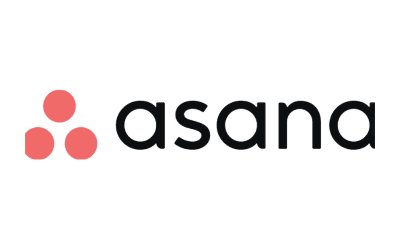 | Effectively manage tasks, projects, and dependencies. | Attach documents and leave comments for contextual task information. | Access a range of support resources, including email and chat. | Visualize project timelines, dependencies, and track project progress. |
 | Manage tasks visually using flexible Kanban-style boards. | Collaboratively share documents and attach them to tasks. | Get help through email, guides, and user forums. | Track tasks using Kanban boards, with some support for complex workflows. |
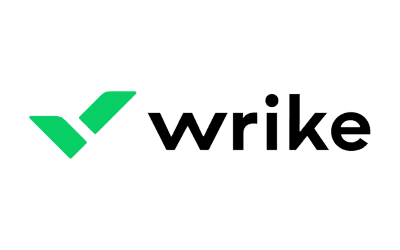 | Seamlessly manage tasks and projects with built-in collaboration. | Share documents with version history and real-time editing. | Access customer support via email, chat, phone, and success plans. | Utilize interactive Gantt charts, visual timelines, and workload management. |
 | Collaboratively manage tasks and projects with advanced reporting. | Share documents and attach them to tasks for seamless collaboration. | Benefit from comprehensive support, including email and chat. | Generate advanced project reports, visualize tasks using Gantt charts. |
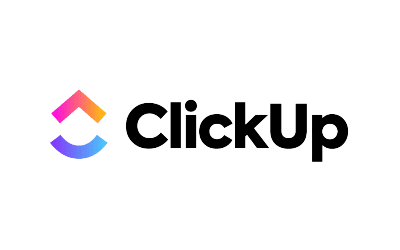 | Streamline task management for diverse work styles. | Collaboratively share and attach documents to enhance teamwork. | Receive assistance through email, chat, and dedicated customer support. | Customize views, leverage Gantt charts, and follow Agile-style workflows. |
 | Collaboratively manage tasks and projects within Zoho Suite. | Share documents and attachments to tasks for collaborative work. | Obtain support through email, phone, and community forums. | Visualize tasks with Gantt charts, monitor dependencies, and track projects. |
 | Simplify project management with communication at the core. | Share documents within projects and utilize file storage. | Access support through email, guides, and user forums. | Emphasize communication, with less focus on complex workflow visualization. |
Alternatives to Gantt Chart with details
Gantt Charts have long been revered for their visual simplicity in depicting a project’s schedule. This unique selling proposition lies in the immediate visual grasp of project timelines and task dependencies.
However, in an age where flexibility, real-time collaboration, and adaptability are paramount, there’s a growing need for alternatives that cater to these complex requirements.
As we transition to a world that seeks more from project management tools, let’s explore 9 more noteworthy alternatives to Gantt Charts, each embracing modern-day needs and functionalities.
Monday.com
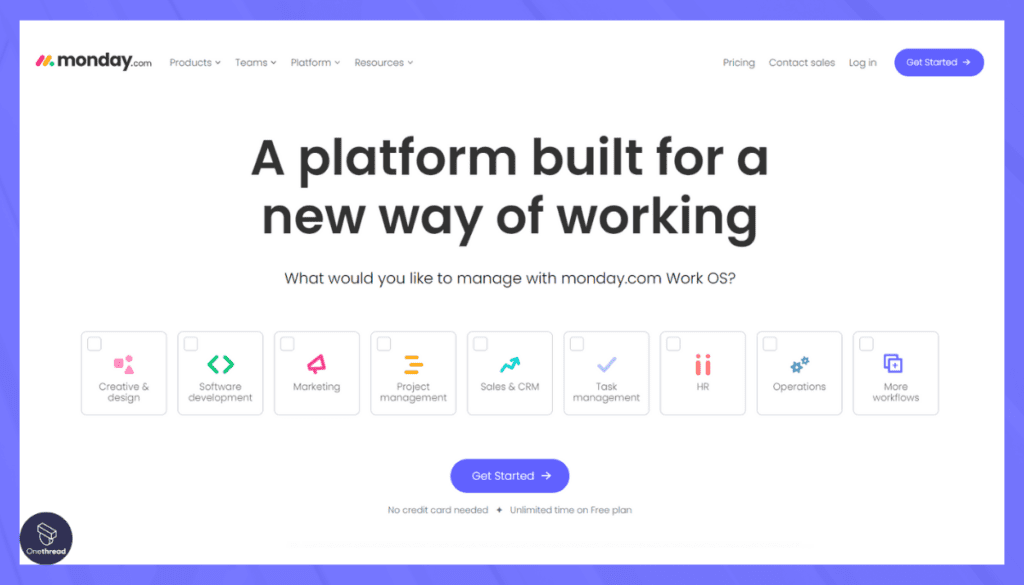
Monday.com is a leading work operating system that powers teams to run projects and workflows with confidence. Launched in 2014, it’s now one of the most prevalent project management solutions across various industries.
The working procedure with Monday.com involves setting up workspaces, defining workflows, assigning tasks, and tracking progress through highly customizable boards.
The benefits include a high degree of flexibility, rich integrations, powerful automation, and transparent communication. Implementation is user-friendly, making it suitable for various project management styles.
- Platforms: Available on the app (iOS, Android), website, and Windows.
- Integrations: Extensive integrations with tools like Slack, Zoom, and Salesforce.
- User Experience (UX): Highly intuitive interface, customizable to fit specific work needs.
Features of Monday.com
Customizable Workflows
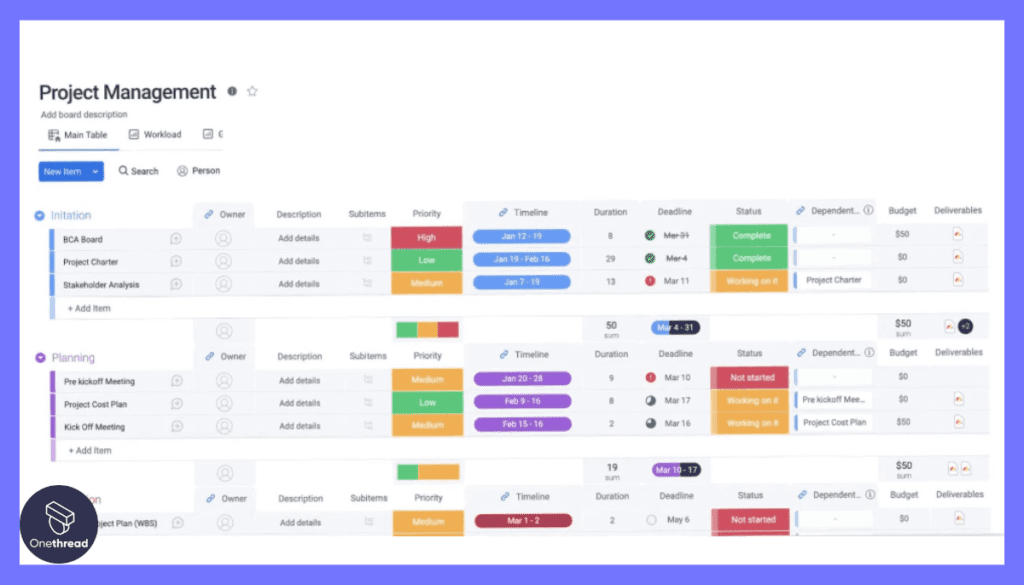
Monday.com offers highly customizable workflows that can be tailored to match your team’s specific processes and methodologies.
Visual Project Tracking
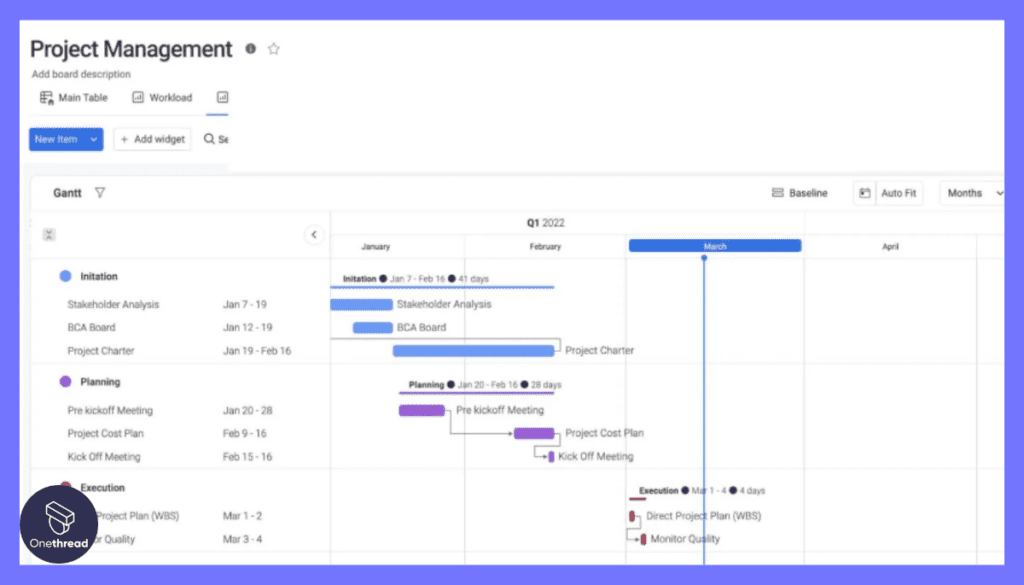
Its visual interface, with customizable columns and views, provides a clear overview of tasks, stages, and progress using color-coded boards.
Automation
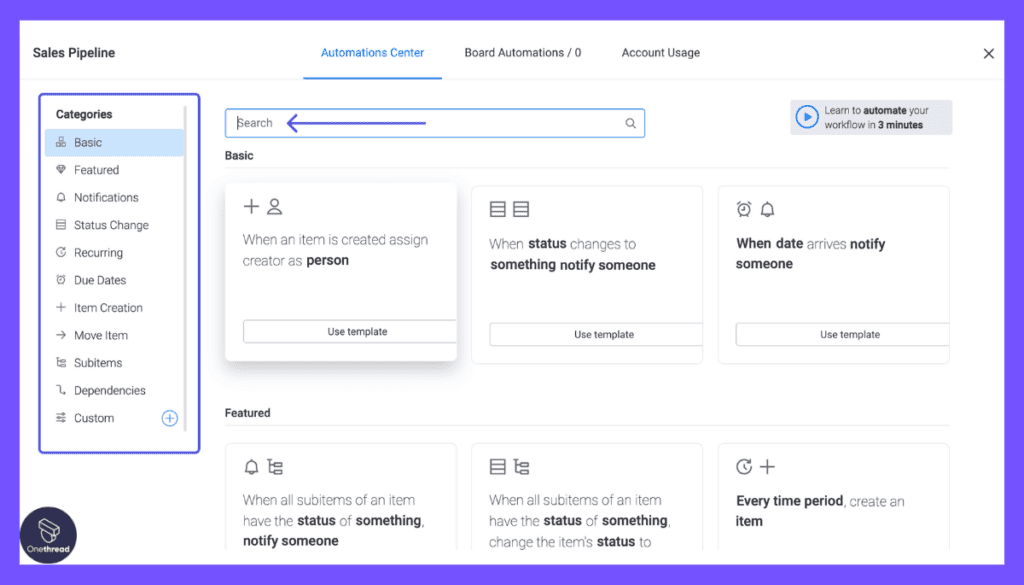
Monday.com’s automation features allow you to set up triggers and actions, automating repetitive tasks and reducing manual work.
Communication Tools
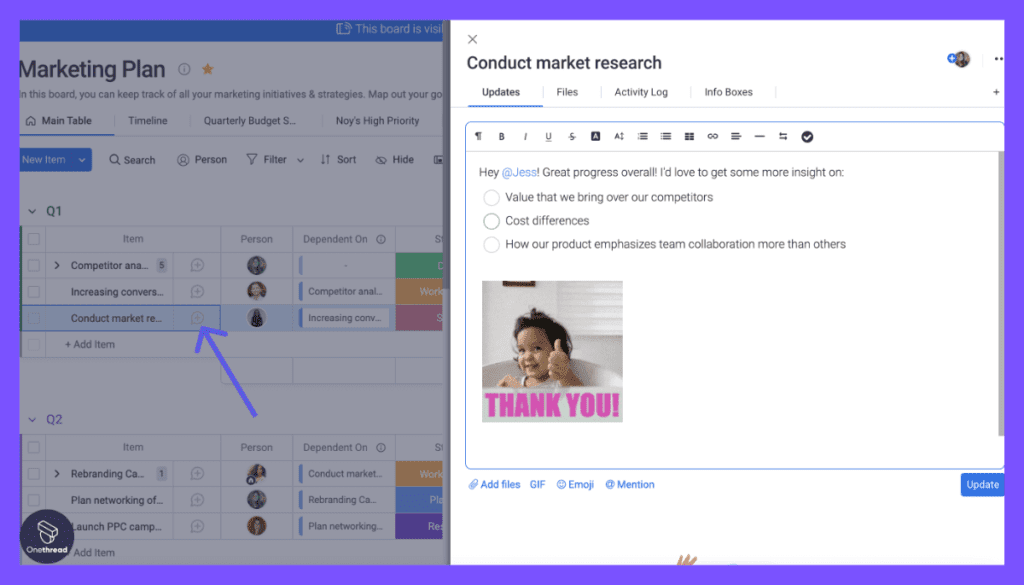
Communication is streamlined within the platform through updates, comments, and direct communication within tasks and projects.
Integration Options
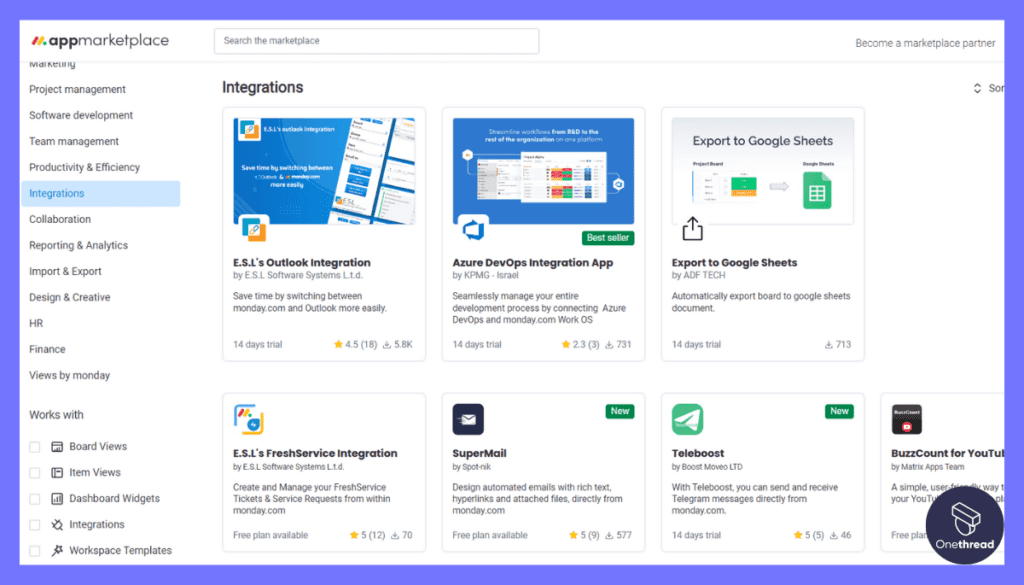
Monday.com integrates with various tools and apps, enhancing its functionality by connecting it to your existing workflow.
Collaboration Features
The platform encourages teamwork with features like assigning tasks, sharing files, and collaborating on shared dashboards, promoting efficient collaboration among team members.
Pros & Cons of Monday.com
Pros
- Customizable workflows
- Visual project tracking
- Automation capabilities
Cons:
- Pricing can be high for larger teams
Customer Ratings
- G2: 4.7 (8,523+ reviews)
- Capterra: 4.6 (4,099+ reviews)
Pricing
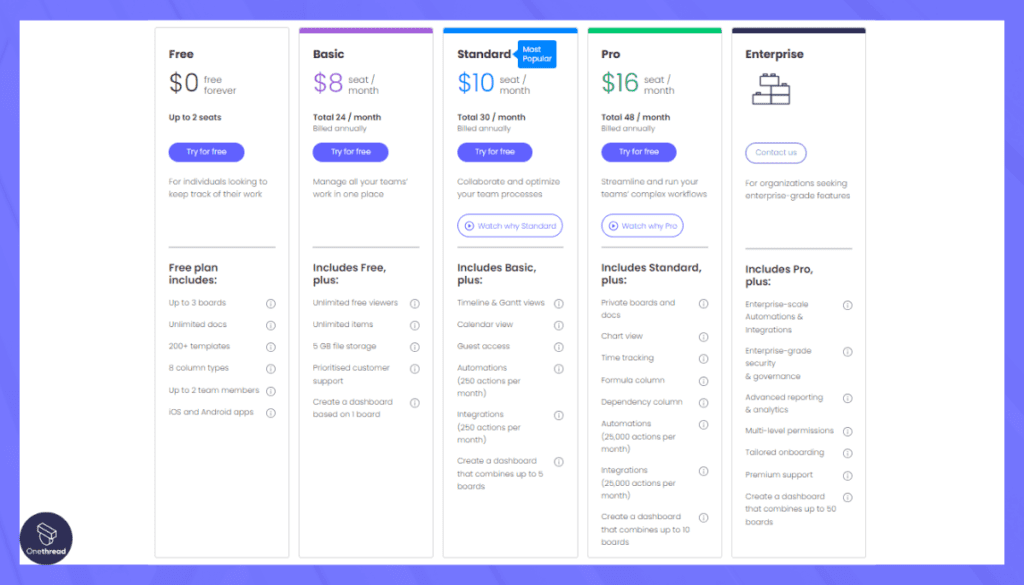
- Free
- Basic: $8/seat/month
- Standard: $10/seat/month
- Pro: $16/seat/month
- Enterprise: Custom pricing
Is Monday.com Better than Gantt Chart?
Monday.com offers a much more dynamic approach to project management compared to traditional Gantt Charts.
With its customizable boards and vast integration capabilities, it provides a level of flexibility and automation that is hard to match with Gantt Charts. Its focus on real-time collaboration and adaptability makes it a powerful alternative.
Our Review of Monday.com
Monday.com stands as an outstanding platform that redefines project management through its adaptability and robust features. Its ability to align with diverse workflows sets it apart, catering to teams of all sizes and industries.
While it may take some time to explore its full potential, the effort pays off in terms of efficiency and productivity gains.
Whether transitioning from Gantt Charts or implementing a project management system for the first time, Monday.com proves to be a versatile and capable choice.
Asana
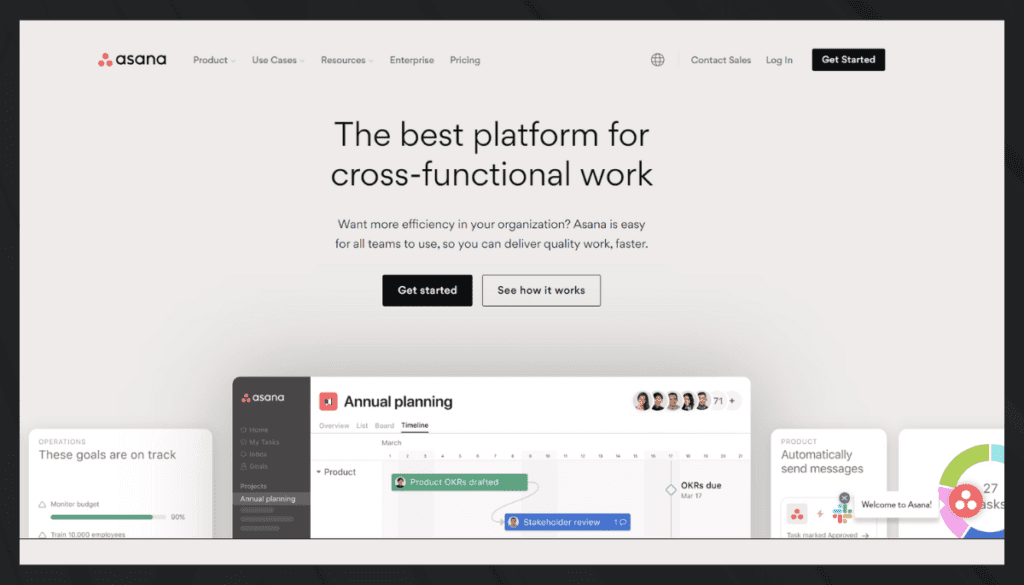
Asana is a prominent project management and collaboration tool that facilitates teams in organizing, tracking, and managing their work. Founded in 2008, it has grown to become a favored tool for various organizations, big and small.
Asana’s working procedure is centered around creating projects, defining goals, assigning tasks, and maintaining timelines.
The platform’s benefits include enhanced collaboration, clear visualization of progress, and strong integrations. Implementation is seamless, allowing for easy adaptation to various project needs.
- Platforms: Available on the app (iOS, Android), and website.
- Integrations: Comprehensive integration with tools like Slack, Google Workspace, Microsoft Office, and more.
- User Experience (UX): Intuitive and user-friendly, with diverse views such as lists, boards, and timelines.
Features of Asana
Task and Project Management:
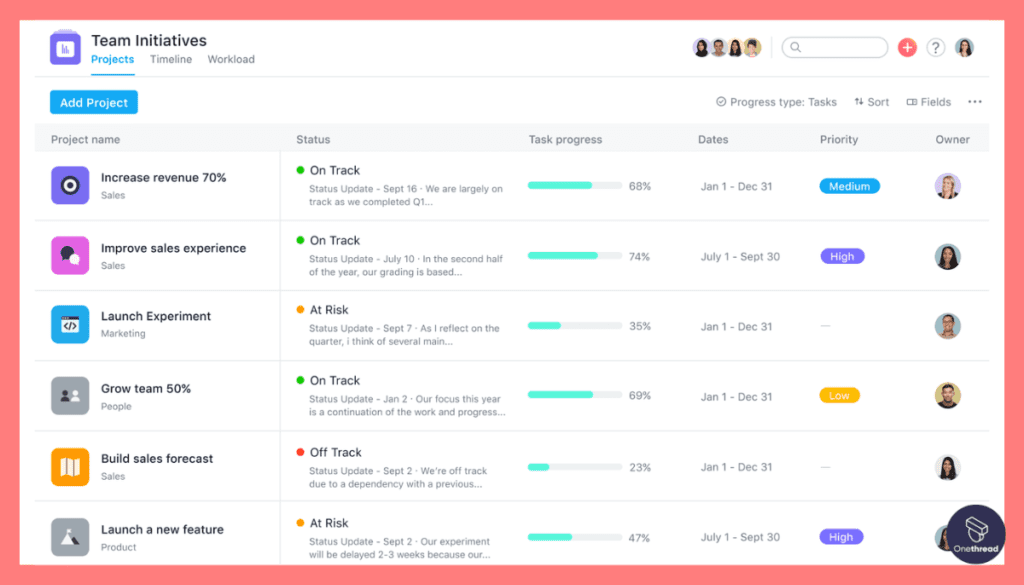
Asana provides a platform for creating, managing, and organizing tasks and projects.
Custom Fields and Templates:
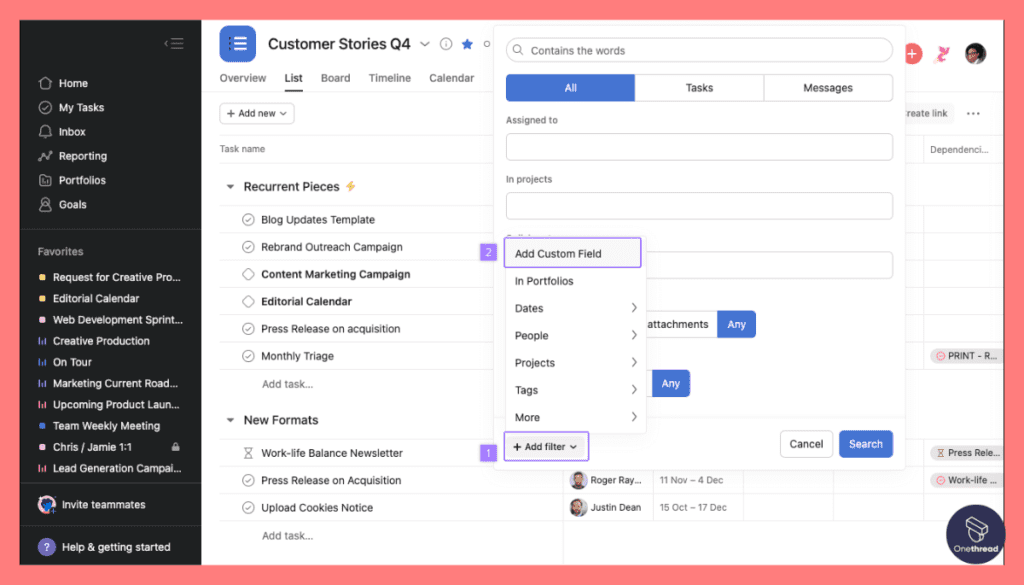
It allows you to customize tasks with specific fields and create templates for recurring project types.
Collaboration and Communication:
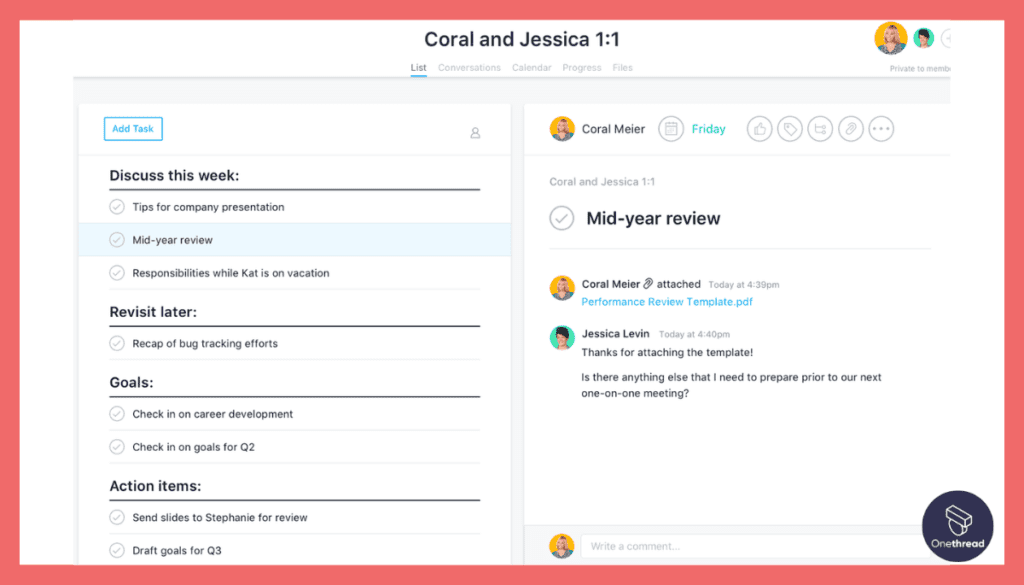
Asana facilitates communication within tasks and projects through comments, attachments, and mentions.
Timeline and Calendar Views:
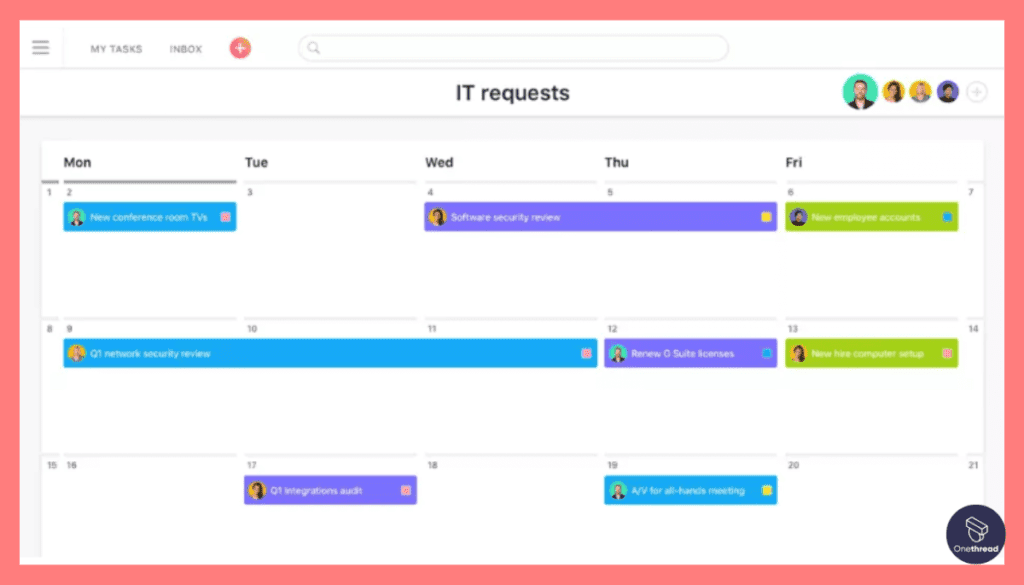
The platform offers visual timeline and calendar views to help plan and manage project schedules effectively.
Integration Options:
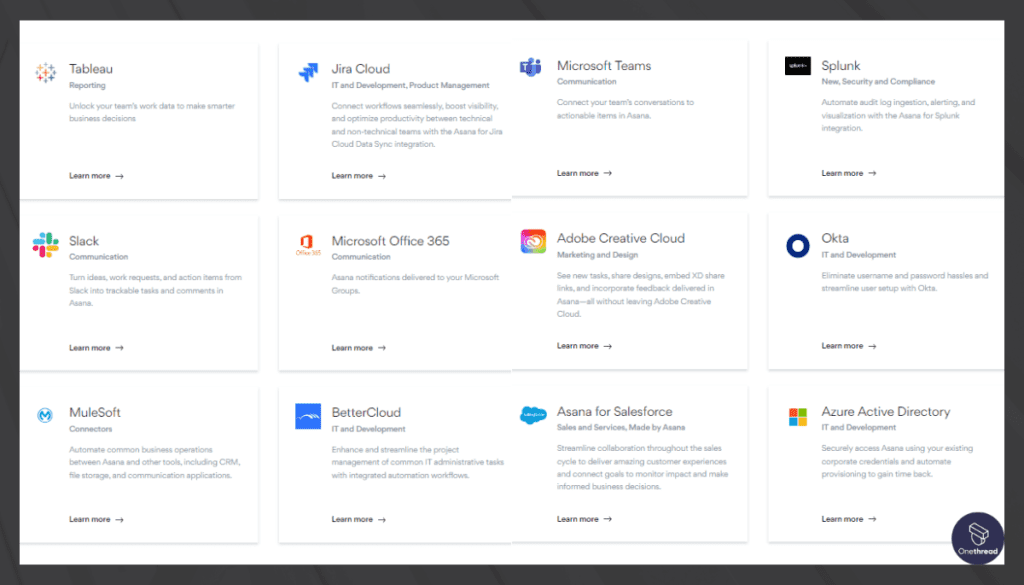
Asana integrates with various tools and apps, allowing you to connect it to your preferred software ecosystem.
Automation:
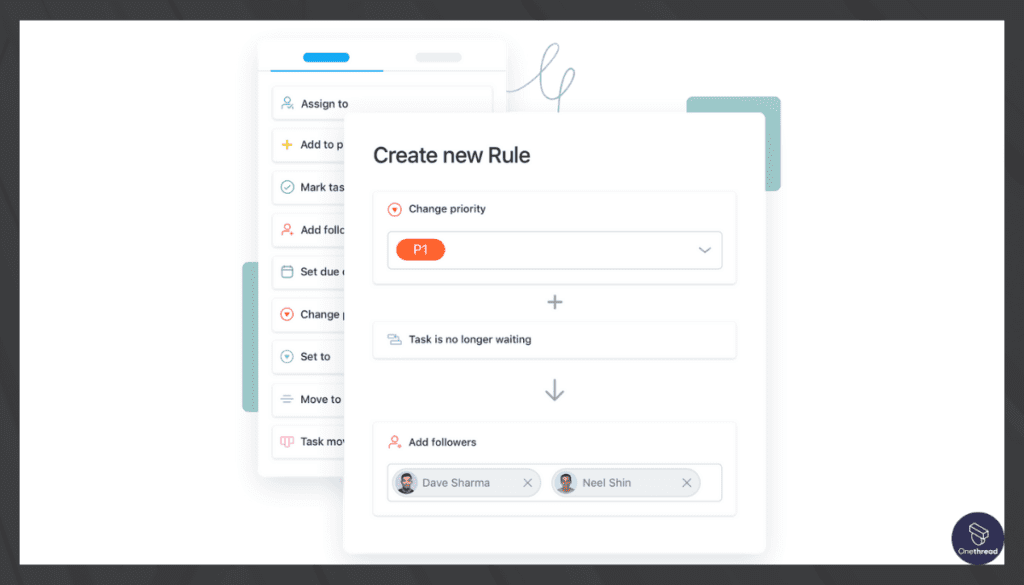
Asana’s automation features enable you to create rules that trigger actions, automating routine processes and task assignments.
Pros & Cons of Asana
Pros
- Task and project management
- Collaboration features
- Integration options
Cons:
- Learning curve for complex setups
Customer Ratings
- G2: 4.3 (9,446+ reviews)
- Capterra: 4.5 (22,681 reviews)
Pricing
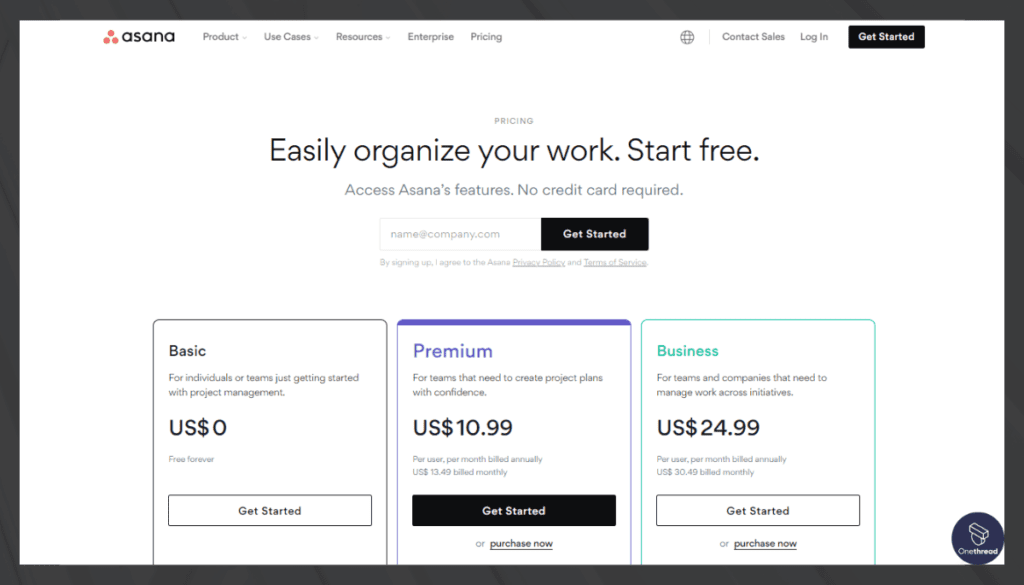
- Basic: Free with unlimited tasks and 100+ integrations.
- Premium: $10.99/user/month with workflow builder.
- Business: $24.99/user/month with advanced customization.
- Enterprise: Custom pricing
Is Asana Better than Gantt Chart?
Asana provides a more flexible and collaborative approach compared to traditional Gantt Charts. With its various views, including a timeline that resembles a Gantt Chart, it adds dynamic capabilities to project management.
Its focus on team collaboration, integrations, and ease of use makes it a compelling Gantt Chart alternative.
Our Review of Asana
Asana offers a rich feature set that emphasizes team collaboration and clear project visualization. Its adaptability to various working styles and the ability to represent tasks in different formats are standout features. While there’s a learning curve for new users, once mastered, it greatly enhances project control and team communication.
Transitioning from Gantt Charts to Asana can significantly improve how teams manage and track projects, providing a more engaging and comprehensive experience.
Whether you’re a freelancer, a small business, or a large corporation, Asana’s robust functionalities make it an excellent choice for modern project management.
Trello
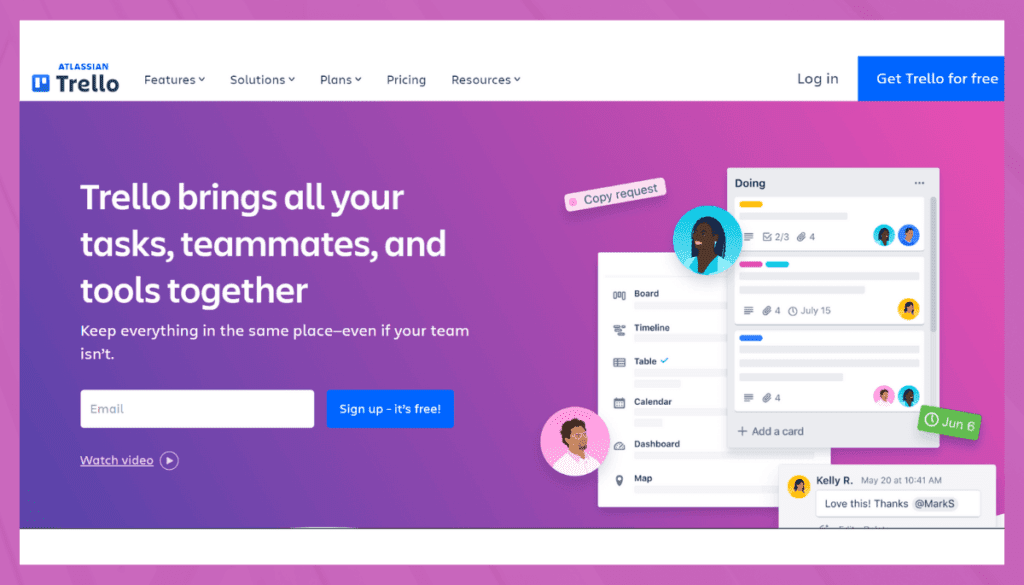
Trello is a popular project management tool that adopts a card-based interface, allowing users to create, organize, and prioritize tasks.
Created in 2011, it has since become a preferred choice for individual and team projects alike. The working procedure of Trello is intuitive; users create boards for projects, lists for stages, and cards for individual tasks.
This visual approach offers a quick overview of ongoing work. Benefits include real-time collaboration, flexibility, and the ability to integrate with various other tools. Implementation is generally hassle-free, fitting into various project management methodologies.
- Platforms: Available on the app (iOS, Android), website, Windows, and macOS.
- Integrations: Supports integrations with popular tools like Slack, Google Drive, and Jira.
- User Experience (UX): Highly user-friendly, visual layout that’s easy to understand and operate.
Features of Trello
Boards, Lists, and Cards:
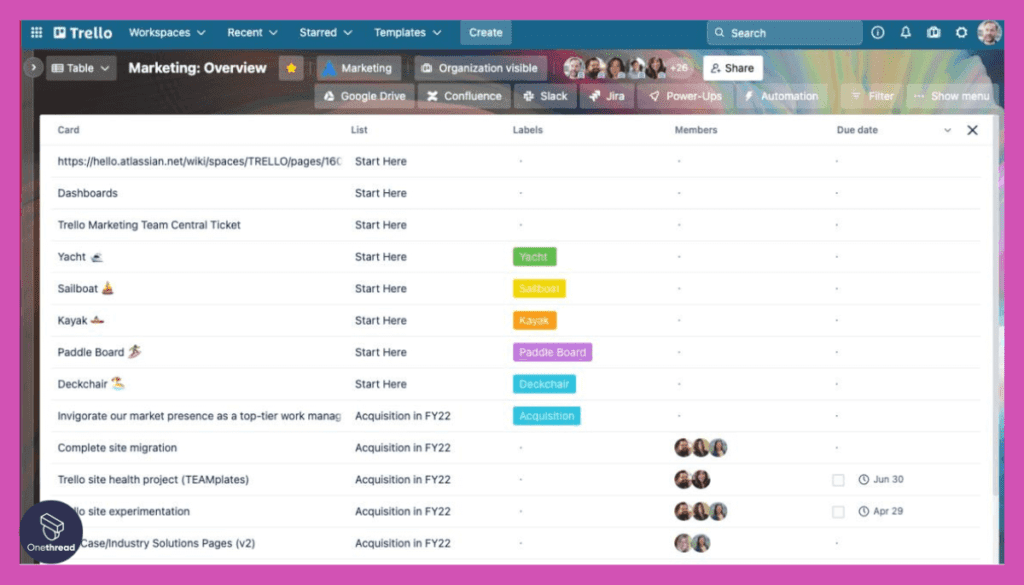
Trello’s foundation lies in its organizational structure. Boards represent projects, lists categorize tasks into stages, and cards contain detailed information about individual tasks or items.
Visual Task Management:
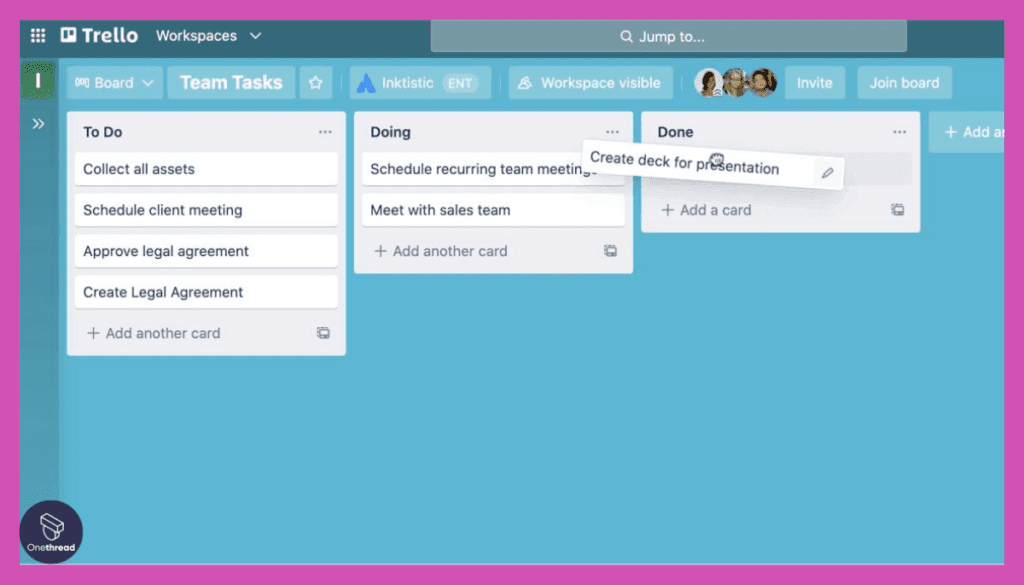
Trello’s visual interface uses drag-and-drop functionality to provide an intuitive way to manage tasks and projects, making it easy to rearrange and prioritize work.
Collaboration and Sharing:
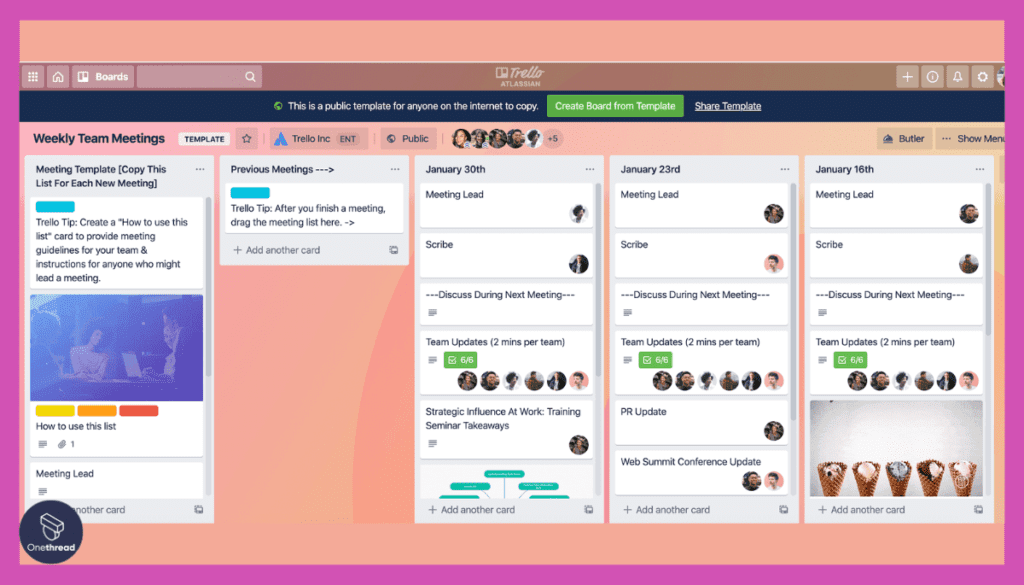
Trello fosters teamwork by allowing users to invite team members to boards, collaborate on tasks, add comments, and share resources within cards.
Checklists and Due Dates:
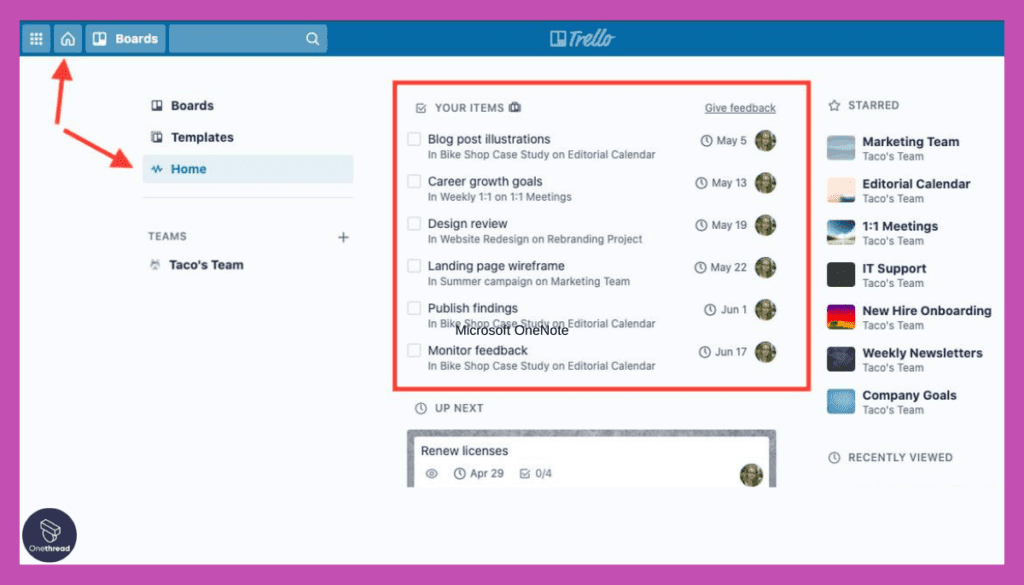
Cards can include checklists for breaking tasks into subtasks, while due dates ensure timely task completion and deadline tracking.
Labels and Filters:
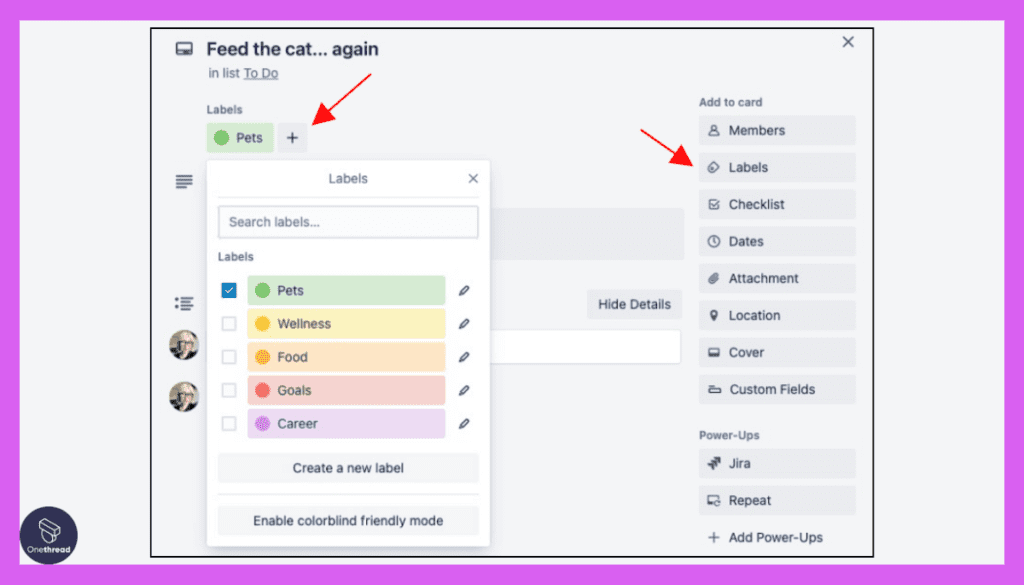
Trello’s labeling system helps categorize and identify tasks based on different criteria. Filters assist in quickly finding specific cards or tasks within a board.
Pros & Cons of Trello
Pros
- Visual task management
- Collaboration and ease of use
- Integration options
Cons:
- Limited in-depth project management features
Customer Ratings
- G2: 4.4 (13,352+ reviews)
- Capterra: 4.5 (22,681+ reviews)
Pricing
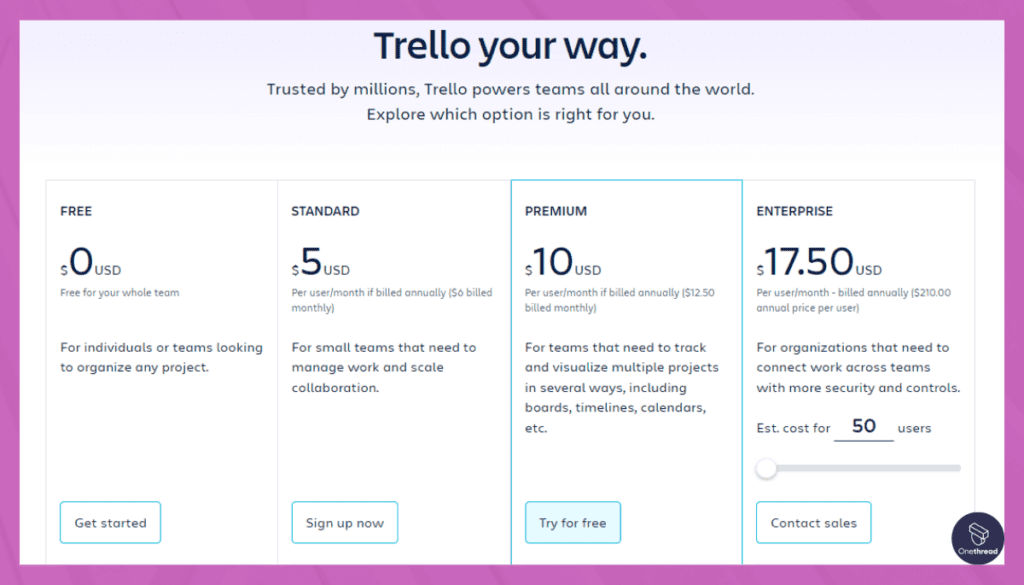
- Free
- Standard: $5/user/month
- Premium: $10/ user/month
- Enterprise: $17.50/ user/month
Is Trello Better than Gantt Chart?
Trello’s strength lies in its adaptability and user-centered design. Unlike traditional Gantt Charts, it facilitates collaboration and provides a more fluid approach to managing tasks. For teams that value flexibility and ease of use, Trello offers a modern alternative to Gantt Charts.
Our Review of Trello
Trello stands out as an accessible and innovative tool that meets the demands of various project scales and complexities. Its card-based structure offers a refreshing take on task management, making it ideal for both newcomers and experienced project managers.
While it may lack some of the detailed scheduling features of a Gantt Chart, its integrations, adaptability, and user-friendly design make it a strong contender in the realm of project management tools.
Whether for individual use or collaborative team efforts, Trello’s versatile approach is well worth considering.
ClickUp
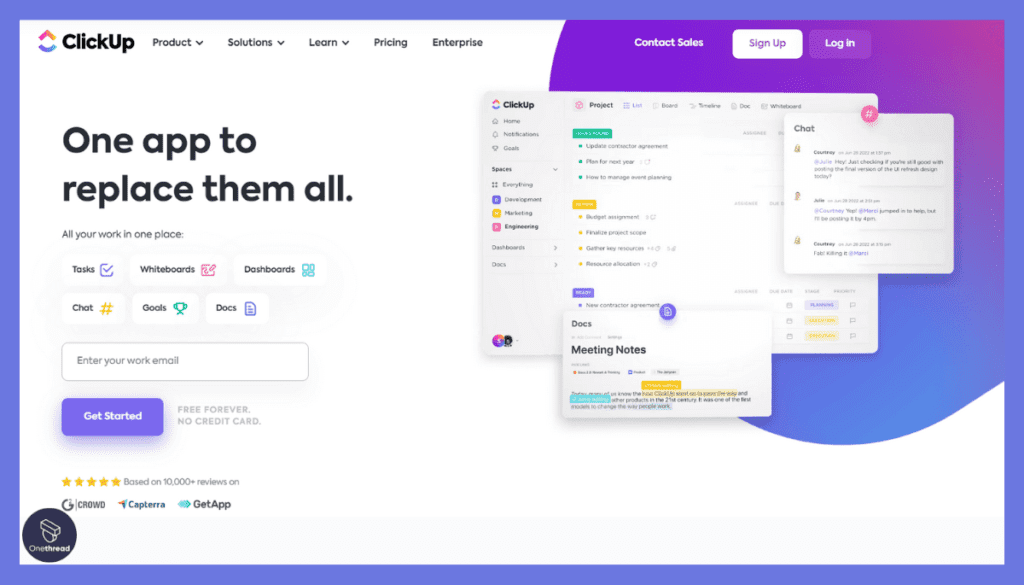
ClickUp is a fast-growing project management and productivity tool that aims to replace other work apps, allowing teams to keep everything from tasks to chats in one place. Launched in 2017, ClickUp is praised for its adaptability and broad array of features.
Its working procedure focuses on creating tasks, setting priorities, collaborating with team members, and tracking time, all within an intuitive interface. The benefits of ClickUp include flexibility in managing diverse projects, real-time collaboration, and high customizability.
- Platforms: Available on the app (iOS, Android), website, Windows, and macOS.
- Integrations: Integrates seamlessly with popular tools like Slack, Google Workspace, Trello, and many more.
- User Experience (UX): Highly customizable interface with different views like lists, boards, and even a Gantt Chart view.
Features of ClickUp
Customizable Views:
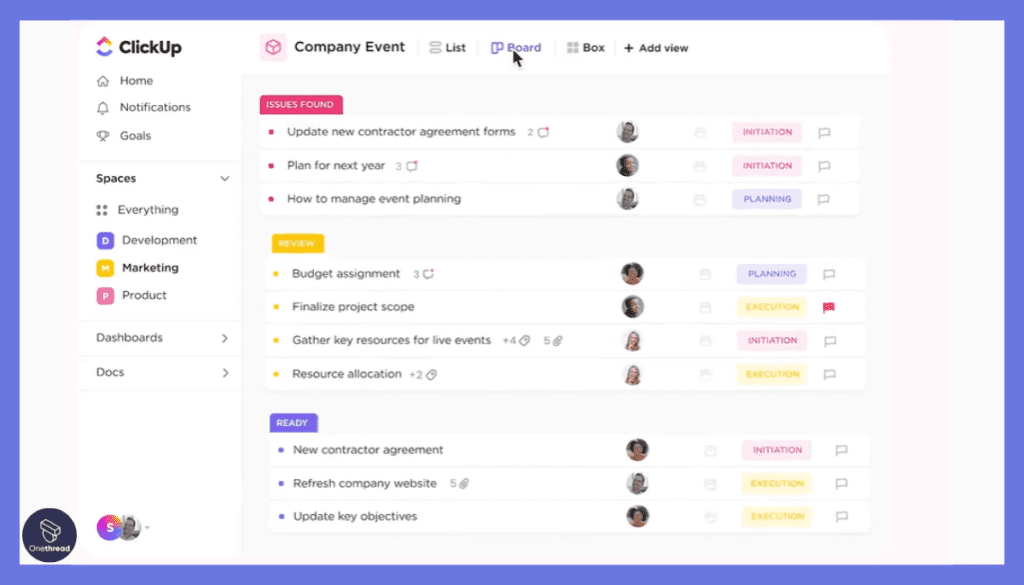
ClickUp offers versatile views including List, Board, Box, Calendar, and Gantt Chart, allowing you to adapt to your preferred workflow.
Task and Project Management:
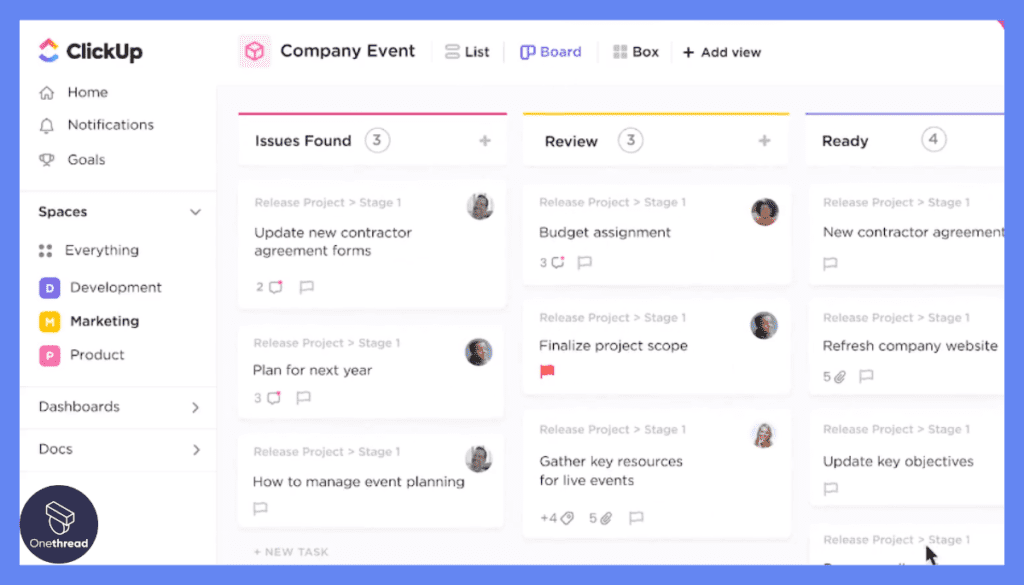
It provides tools for creating, organizing, and managing tasks and projects.
Automation:
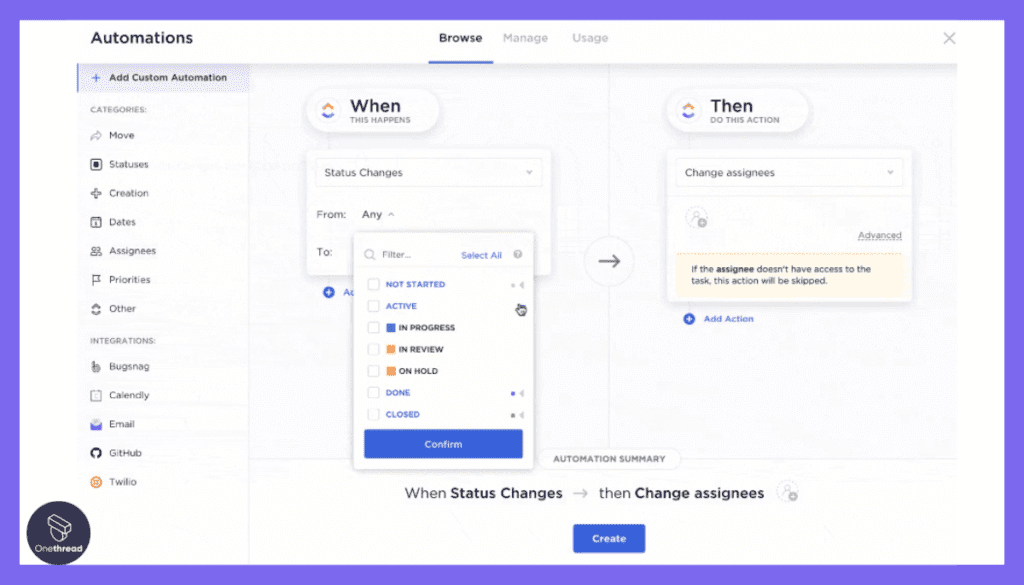
ClickUp’s automation features enable you to automate repetitive tasks and actions, improving efficiency.
Collaboration and Communication:
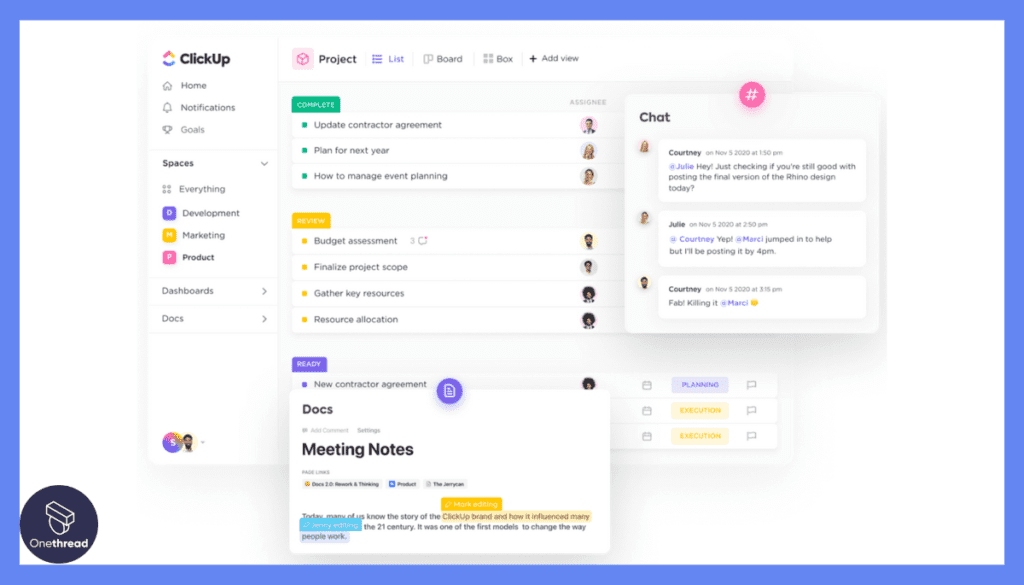
The platform facilitates team collaboration with features like comments, @mentions, and task sharing.
Time Tracking and Goals:
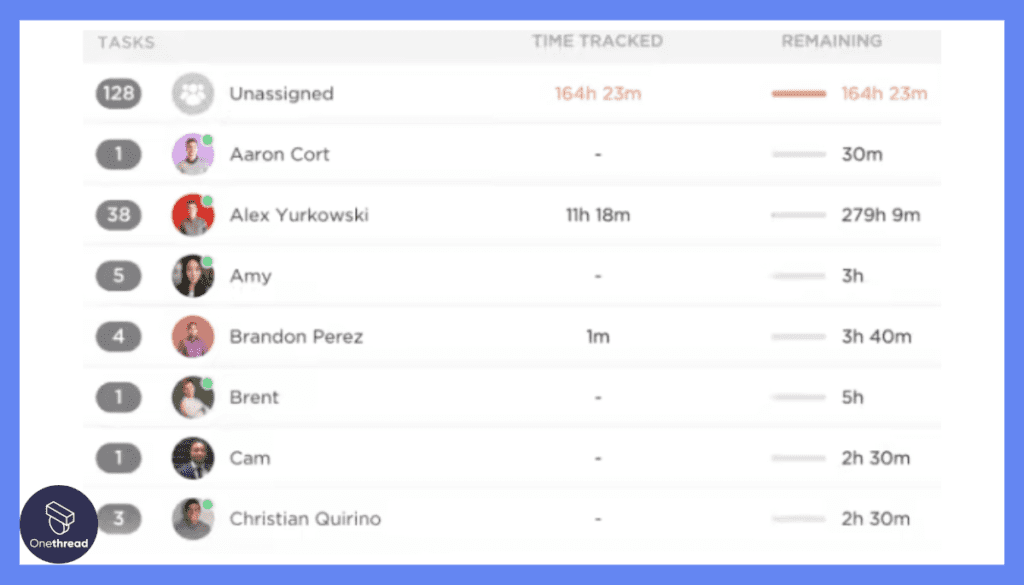
ClickUp includes time-tracking functionalities and allows you to set and track project goals.
Integrations:
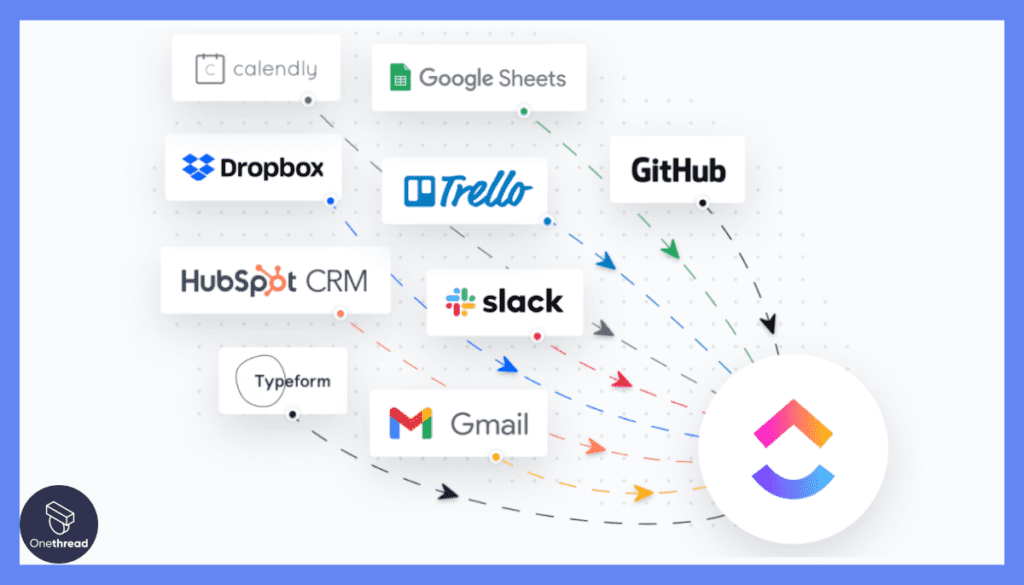
ClickUp integrates with various tools and apps, enhancing its functionality by connecting with your existing tools.
Customization and Templates:
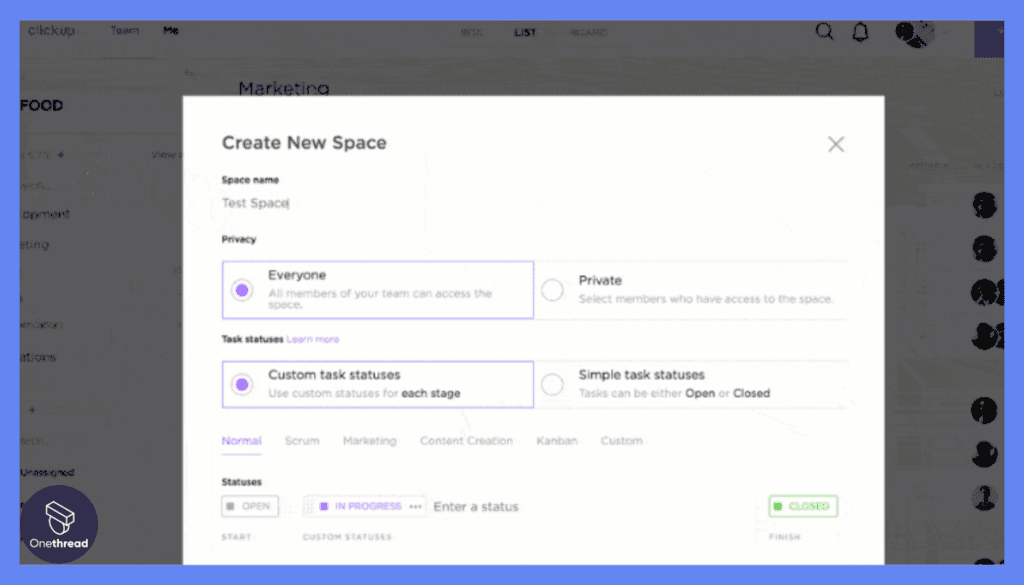
It offers customizable fields, statuses, and templates, allowing you to tailor ClickUp to your specific needs.
Pros & Cons of ClickUp
Pros
- Customizable views
- Automation and productivity features
- Integration capabilities
Cons
- The learning curve for advanced features
Customer Ratings
- G2: 4.7 (8,543+ reviews)
- Capterra: 4.7 (3,755+ reviews)
Pricing
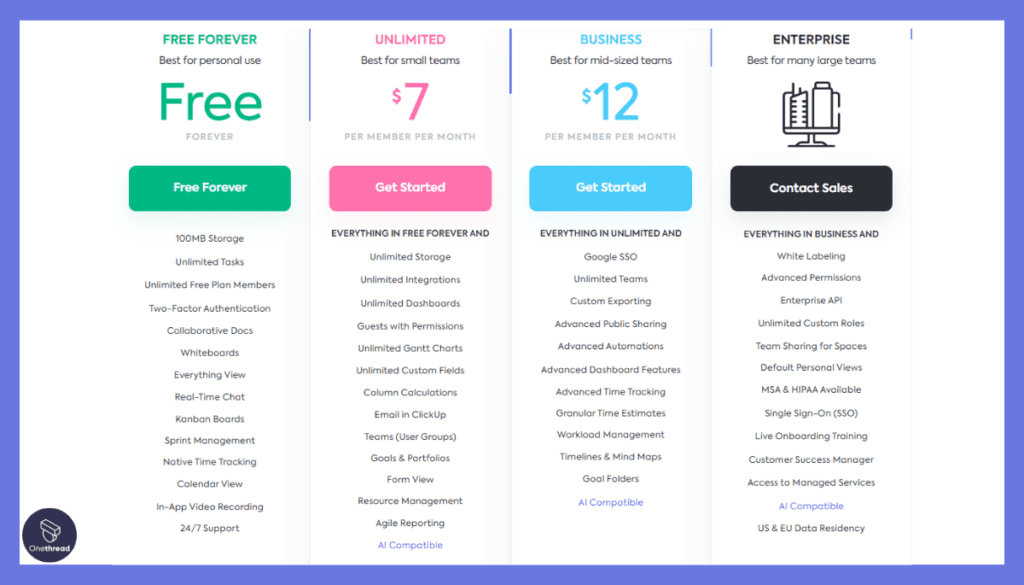
- Free
- Unlimited: $10.99/user/month
- Business: $19/user/month
- Enterprise: Custom pricing
Is ClickUp Better than Gantt Chart?
ClickUp takes the concept of Gantt Charts and enhances it by integrating it with other tools, allowing customization, and supporting real-time collaboration. It provides more than just a Gantt Chart view, enabling a multifaceted approach to project management.
Our Review of ClickUp
ClickUp stands out with its mission to replace other work apps, offering a central hub for various work needs. Its strength lies in its adaptability and extensive feature set, which might seem overwhelming at first but offers great depth for different project needs. The ability to switch between different views, including a Gantt Chart view, adds to its appeal.
Whether you’re looking to manage simple tasks or complex projects, ClickUp’s versatile platform can adapt to your needs. The pricing structure caters to different users, from individuals to large corporations, making ClickUp a powerful Gantt Chart alternative worth considering.
Zoho Projects
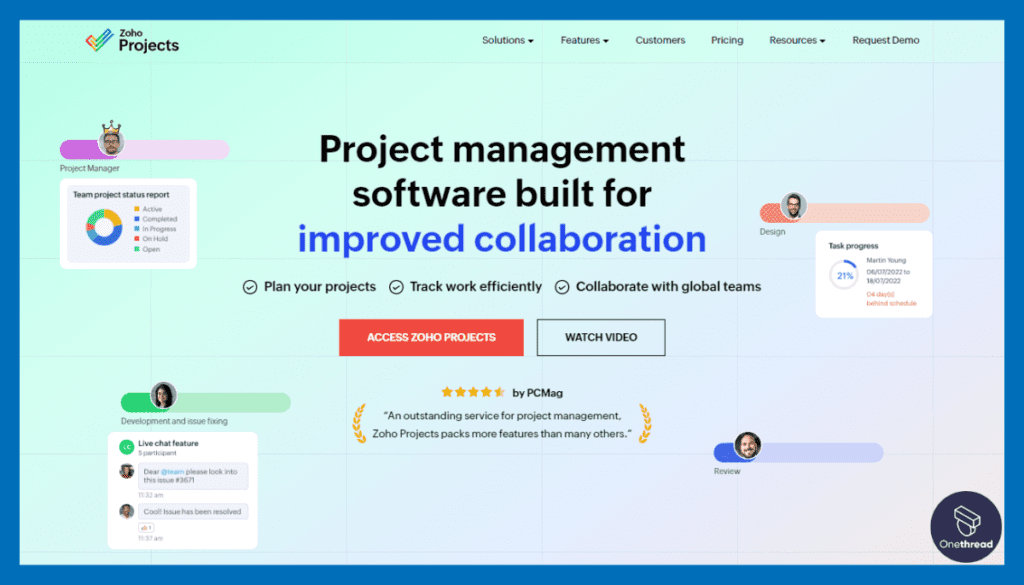
Zoho Projects is a comprehensive project management tool that’s part of the Zoho suite, offering a blend of collaboration, planning, and tracking functionalities. Launched in 2006, Zoho Projects has been a reliable option for businesses looking for an efficient way to manage their projects.
Its working procedure encompasses creating tasks, setting milestones, assigning roles, and generating in-depth reports. Benefits include ease of collaboration, robust reporting tools, and seamless integration with other Zoho products.
- Platforms: Available on the app (iOS, Android), and website.
- Integrations: Smoothly integrates with other Zoho apps and popular tools like Google Workspace, and Microsoft Office.
- User Experience (UX): Intuitive interface with different views, including Gantt Charts, Task Lists, and Boards.
Features of Zoho Projects
Task and Project Management:
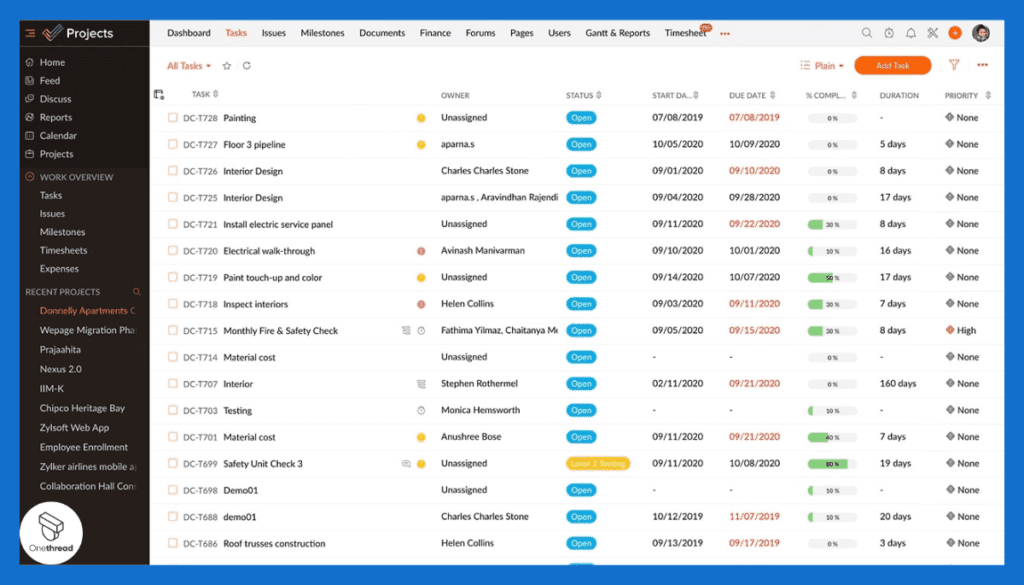
Zoho Projects provides tools for creating, organizing, and managing tasks and projects.
Gantt Charts:
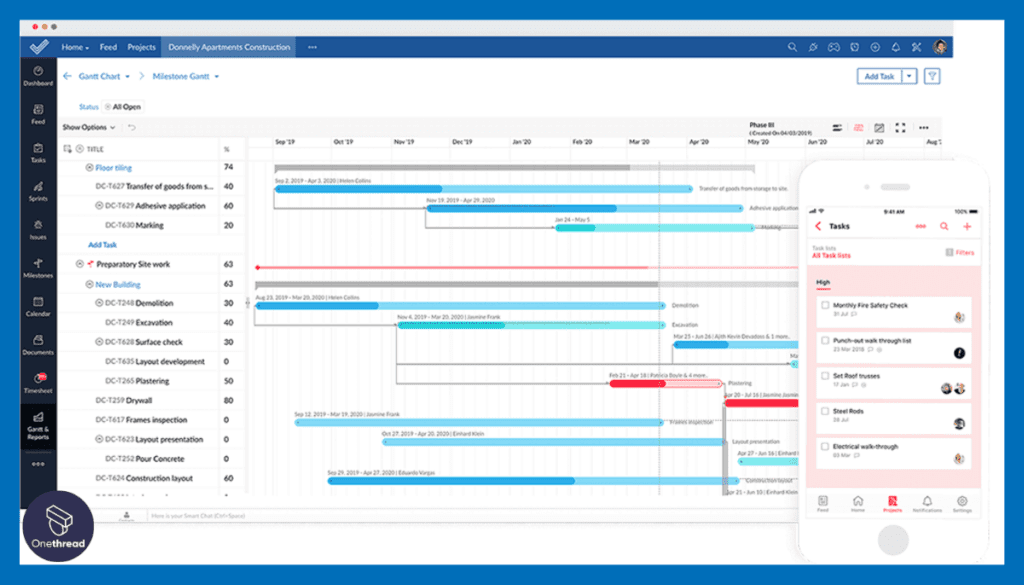
The platform offers Gantt chart views for visualizing project schedules and dependencies.
Time Tracking:
Zoho Projects includes time tracking capabilities to monitor work hours and project progress.
Collaboration Tools:
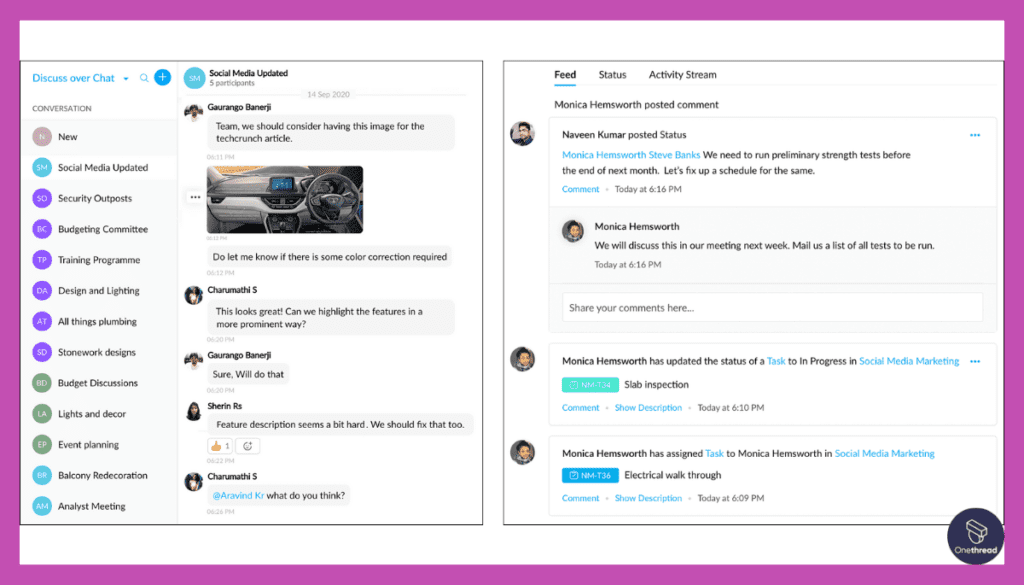
It facilitates team collaboration through discussions, file sharing, and commenting on tasks and projects.
Integration Capabilities:
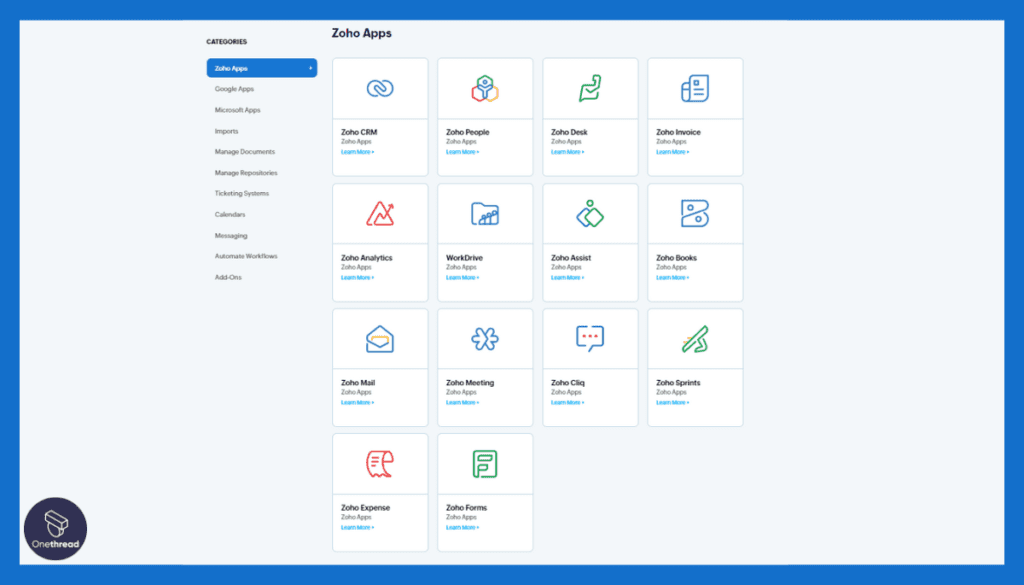
Zoho Projects integrates with various apps and tools, enhancing its functionality and connectivity.
Reports and Analytics:
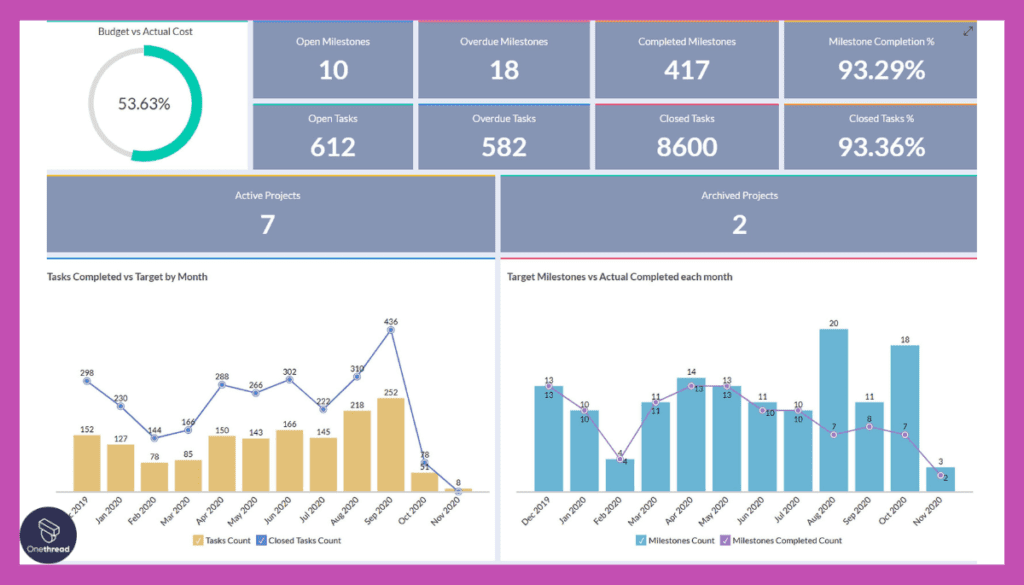
The platform offers reporting and analytics features to track project performance, resource utilization, and more.
Document Management:
Zoho Projects provides document storage and sharing, keeping project-related files organized and accessible.
Pros & Cons of Zoho Projects
Pros
- Task and project management
- Gantt charts and integration options
- Collaboration features
Cons
- UI/UX improvements needed
Customer Ratings
- G2: 4.3 (371+ reviews)
- Capterra: 4.3 (365+ reviews)
Pricing
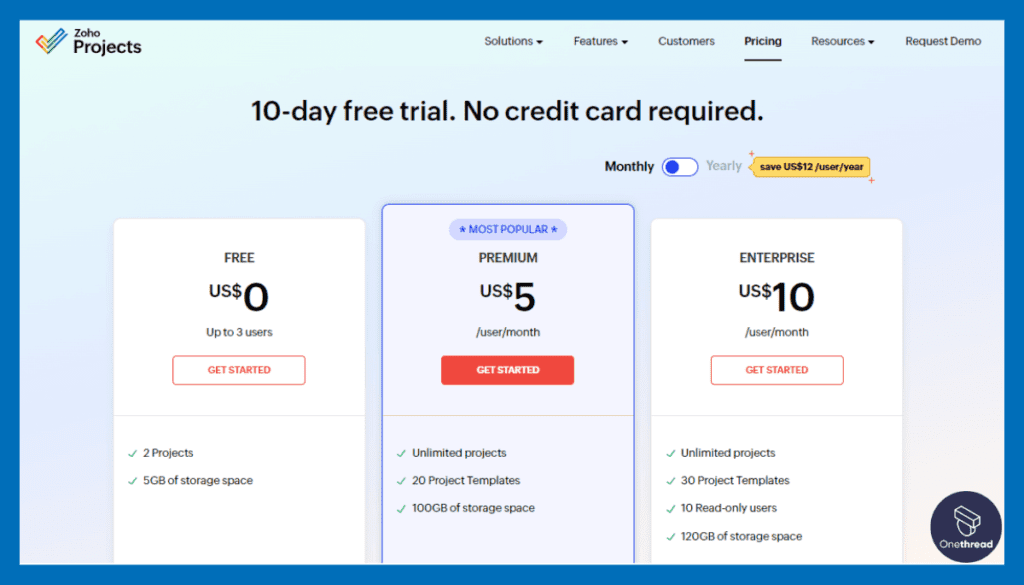
- Free
- Premium: $5/user/month
- Enterprise: $10/user/month
Is Zoho Projects Better than Gantt Chart?
Zoho Projects incorporates Gantt Charts but builds on them with collaboration features, integration options, and robust reporting tools. This makes it a flexible and dynamic alternative to traditional Gantt Charts for project management.
Our Review of Zoho Projects
Zoho Projects distinguishes itself as a comprehensive tool that balances functionality and ease of use. Its integration with other Zoho products and third-party tools adds to its appeal to businesses already invested in the Zoho ecosystem.
The range of views, including Gantt Charts, allows users to approach project management in a way that suits their preferences. While it may not boast as flashy an interface as some newer tools, its dependable functionality and competitive pricing make it a solid choice for businesses looking for a practical, no-nonsense approach to project management.
Whether you’re managing simple tasks or complex multi-stage projects, Zoho Projects provides a well-rounded alternative to traditional Gantt Charts.
Kissflow
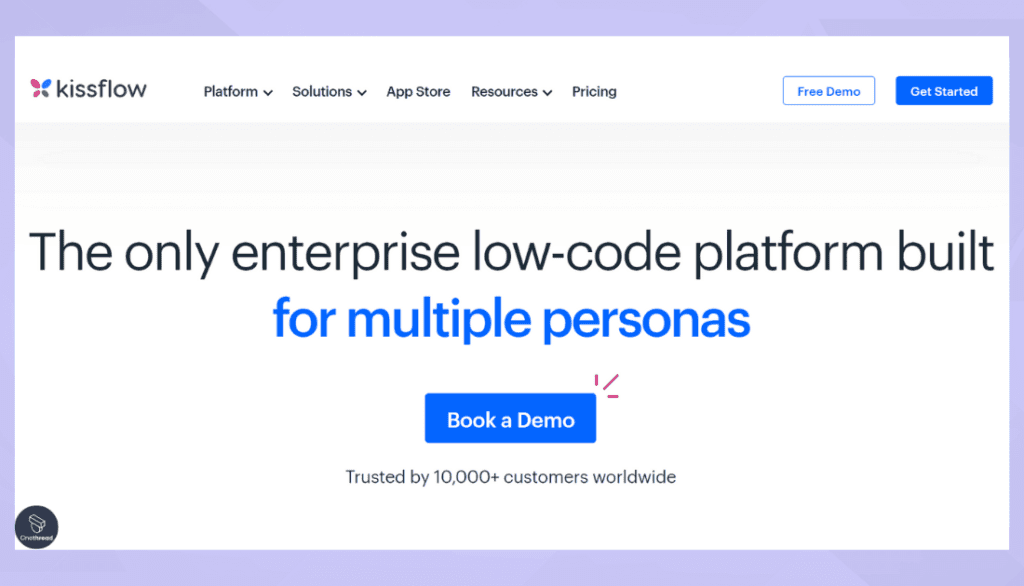
Kissflow is a unified digital workplace platform that offers a range of solutions, including project management, workflow automation, and team collaboration. Launched in 2012, it aims to simplify work processes through automation and integration.
The working procedure within Kissflow involves creating workflows, assigning tasks, automating repetitive actions, and monitoring progress through visually appealing dashboards.
Benefits include increased efficiency, streamlined processes, and improved collaboration across team members. Implementation across various organizational structures is generally smooth and intuitive.
- Platforms: Available on the app (iOS, Android), and website.
- Integrations: Integrates with popular tools such as Slack, Google Workspace, Microsoft Office, and more.
- User Experience (UX): User-friendly design that emphasizes simplicity and efficiency.
Features of Kissflow
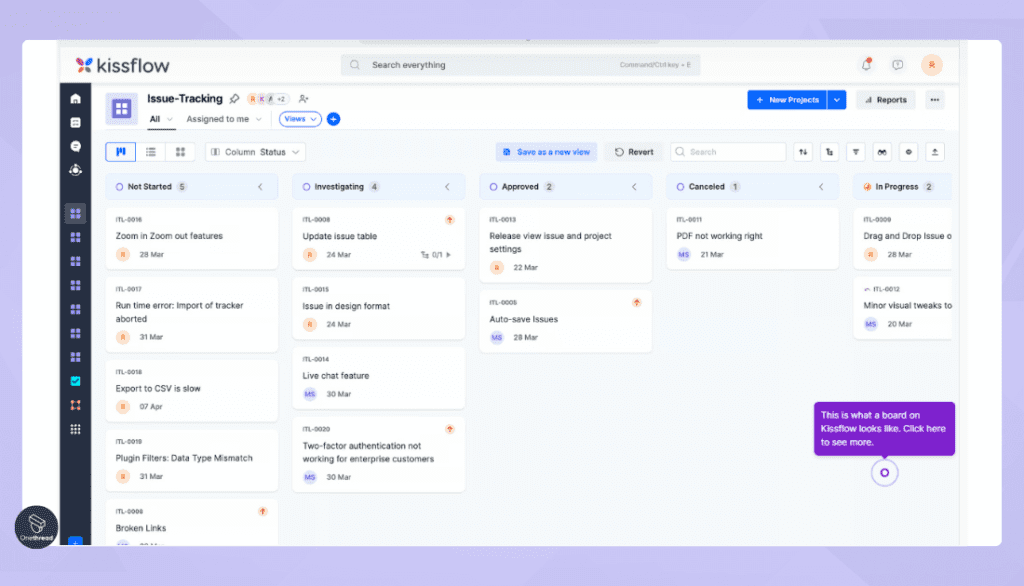
- Process Automation: Kissflow enables the automation of repetitive tasks and workflows, increasing efficiency and reducing manual effort.
- Workflow Management: The platform provides tools to design, manage, and optimize workflows according to your specific business processes.
- Collaboration Tools: Kissflow fosters collaboration through real-time updates, comments, and notifications within tasks and processes.
- Forms and Data Collection: It offers the ability to create custom forms for data collection, making it easy to gather and store information.
- Integration Capabilities: Kissflow integrates with other tools and apps, enhancing its functionality by connecting it with your existing software ecosystem.
- Customizable Templates: The platform provides pre-built templates that can be customized to suit your unique workflow needs, helping you get started quickly.
Pros & Cons of Kissflow
Pros
- Process automation
- Collaboration tools
- Customizable templates
Cons:
- May not be as feature-rich for complex projects
Customer Ratings
- G2: 4.3 (531 reviews)
- Capterra: 3.9 (36 reviews)
Pricing
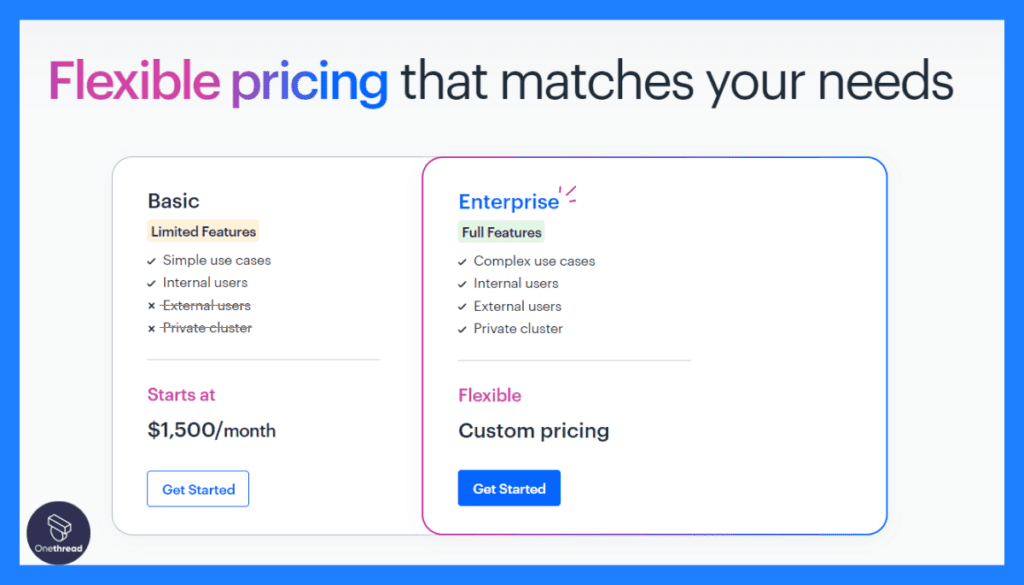
- Basic: $10/user/month
- Fully Loaded: $19/user/month
- Enterprise: Custom pricing
Is Kissflow Better than Gantt Chart?
Kissflow’s appeal lies in its ability to integrate various work functions into a single platform, something that traditional Gantt Charts lack. By offering workflow automation alongside project management, it provides a holistic solution that caters to modern organizational needs.
Its adaptability and integration capabilities make it a strong Gantt Chart alternative.
Our Review of Kissflow
Kissflow stands out as a well-rounded digital workplace solution, extending beyond mere project management. Its automation capabilities and the ease with which it allows the creation and management of workflows are particularly impressive.
The pricing structure accommodates different business sizes, and the platform’s design is focused on user engagement and efficiency.
While not a direct competitor to traditional Gantt Charts in all aspects, its broader functionality and modern approach make Kissflow a valuable tool for organizations seeking a comprehensive solution to manage and automate various work processes.
Wrike
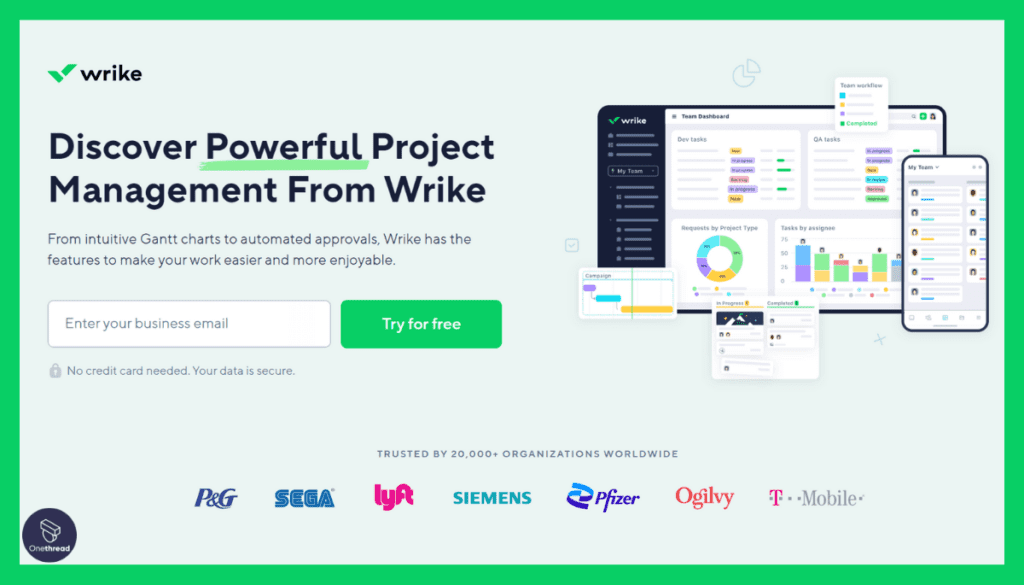
Wrike is a versatile project management platform that allows teams to collaborate, plan, and track projects in real time. Launched in 2006, Wrike has become known for its customizable dashboards, workflow automations, and wide range of integrations.
Its working procedure involves creating tasks, defining goals, assigning resources, and monitoring project timelines, all within a cohesive interface.
Benefits include streamlined project tracking, scalability, and adaptability to various project methodologies, making implementation a breeze for different organizational needs.
- Platforms: Available on the app (iOS, Android), website, Windows, and macOS.
- Integrations: Extensive integrations with tools like Salesforce, Google Workspace, Microsoft Office, and more.
- User Experience (UX): Offers a clean and intuitive interface, with various views including Gantt Charts, lists, and boards.
Features of Wrike
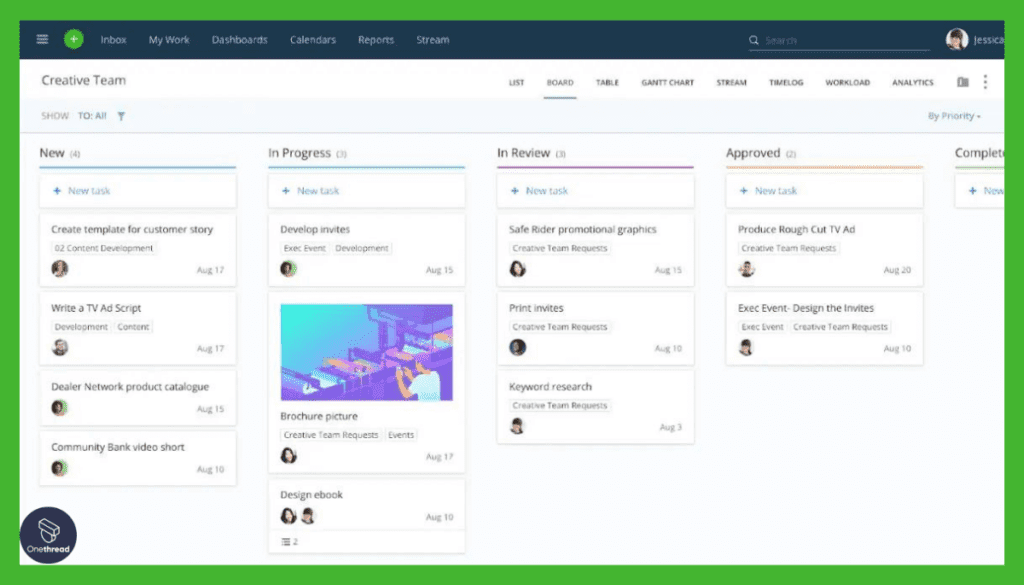
Task and Project Management: Wrike provides tools for creating, organizing, and managing tasks and projects.
Customizable Workflows: It offers customizable workflows to match your team’s processes, improving efficiency and consistency.
Gantt Charts and Timeline View: Wrike includes Gantt chart and timeline views for visualizing project schedules and dependencies.
Collaboration Tools: The platform facilitates team collaboration through task discussions, file sharing, and real-time updates.
Automation:
Wrike’s automation features help streamline tasks by automating routine processes and task assignments.
Reports and Analytics: It offers reporting and analytics tools to track project progress, resource allocation, and team performance.
Pros & Cons of Wrike
Pros
- Customizable workflows
- Gantt charts and timeline view
- Automation features
Cons
- Complexity can be overwhelming for small projects
Customer Ratings
- G2: 4.2 (3,466+ reviews)
- Capterra: 4.3 (2,441+ reviews)
Pricing
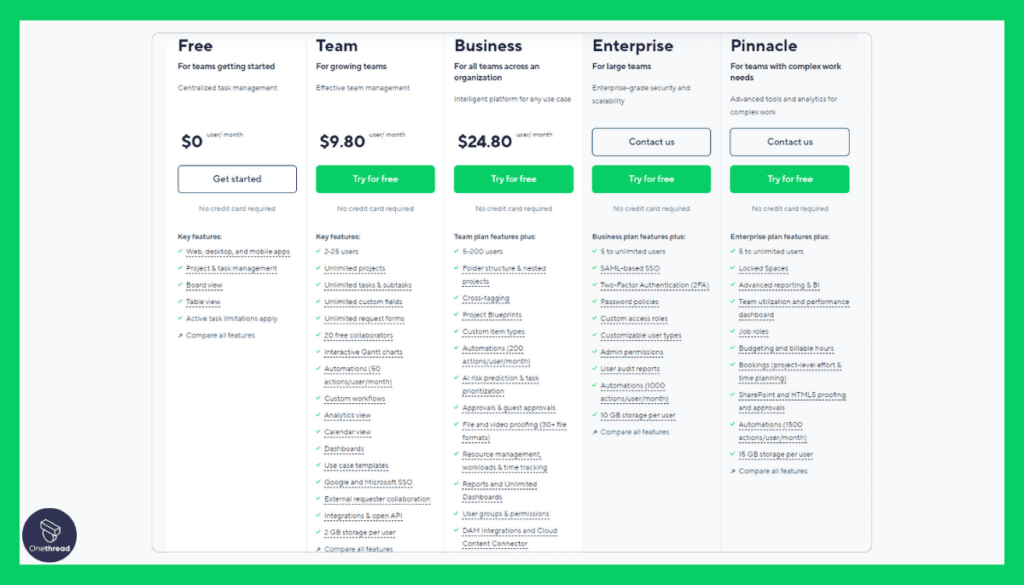
- Free
- Team: $9.80/user/month
- Business: $24.80/user/month
- Enterprise: Custom pricing
Is Wrike Better than Gantt Chart?
Wrike incorporates the concept of Gantt Charts within its platform but enhances it with real-time collaboration, automation, and customization features.
This enables a more dynamic and comprehensive approach to project management, making it a viable alternative to standalone Gantt Charts.
Our Review of Wrike
Wrike excels in offering a multifaceted project management solution. Its adaptability to various project needs and integration capabilities stand out. While the multitude of features may seem overwhelming at first, the learning curve is justified by the control and efficiency gains.
Its ability to even represent information in a Gantt Chart format, while also providing modern collaboration tools, allows for a smooth transition from traditional Gantt Charts.
From small teams to large enterprises, Wrike’s flexibility makes it an attractive option for those looking to elevate their project management to the next level.
Smartsheet
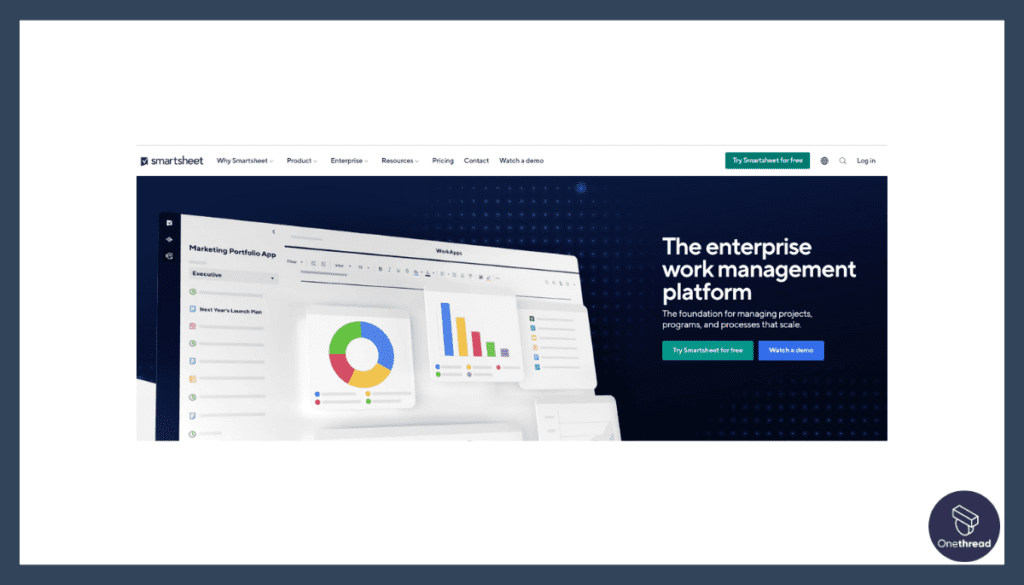
Smartsheet is a dynamic platform that combines traditional spreadsheet layouts with robust project management tools. Founded in 2005, Smartsheet has made waves by enhancing the familiar spreadsheet experience to enable collaboration, automation, and tracking.
The platform’s working procedure allows for task creation, resource allocation, timeline tracking, and powerful reporting.
Benefits include the familiar spreadsheet interface, adaptability across different project types, and strong integration capabilities. Implementation is usually straightforward, especially for those accustomed to spreadsheet-based work.
- Platforms: Available on the app (iOS, Android), and website.
- Integrations: Integrates with popular tools like Slack, Microsoft Office, Google Workspace, Salesforce, and more.
- User Experience (UX): Utilizes a familiar spreadsheet format, augmented with collaboration and automation features.
Features of Smartsheet
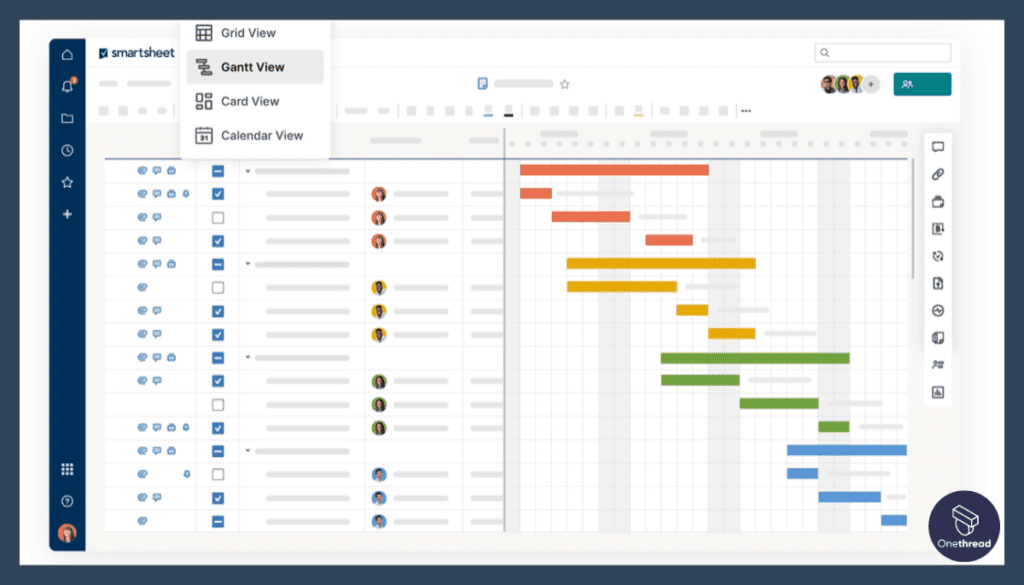
- Grid and Card Views: Smartsheet offers flexible grid and card views to organize tasks and projects visually.
- Automations and Workflows: The platform allows you to create automated workflows, reducing manual tasks and increasing efficiency.
- Collaboration and Sharing: Smartsheet fosters collaboration through real-time editing, comments, and file sharing within sheets.
- Gantt Charts and Calendar Views: It provides Gantt chart and calendar views for comprehensive project planning and scheduling.
- Forms and Data Collection: Smartsheet enables the creation of custom forms to gather and manage data seamlessly.
- Integration Capabilities: The platform integrates with various apps and services to enhance its functionality and connectivity.
- Reports and Dashboards: Smartsheet offers customizable reports and dashboards for tracking project progress, performance, and insights.
Pros & Cons of Smartsheet
Pros
- Versatile grid and card views
- Automation and workflows
- Collaboration and sharing
Cons:
- Interface can be complex for beginners
Customer Ratings
- G2: 4.4 (14,083+ reviews)
- Capterra: 4.5 (2,975+ reviews)
Pricing
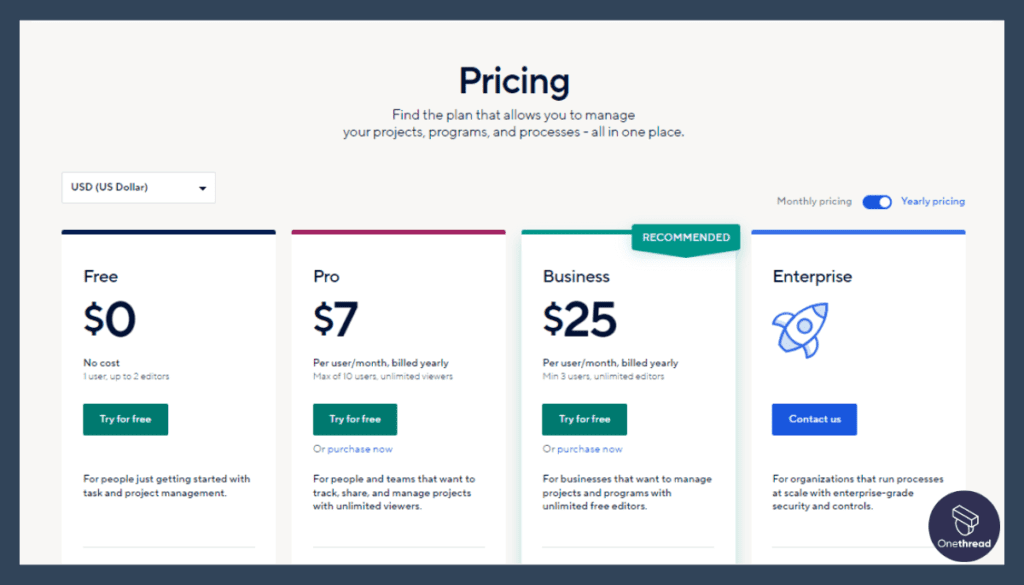
- Free
- Pro: $7/user/month
- Business: $25/user/month
- Enterprise: Custom pricing
Is Smartsheet Better than Gantt Chart?
Smartsheet elevates the traditional spreadsheet experience with features that mirror and extend Gantt Chart functionalities.
Its combination of familiarity with innovation offers a dynamic way to manage projects, making it an attractive alternative to conventional Gantt Charts.
Our Review of Smartsheet
Smartsheet is uniquely positioned as a tool that builds upon the familiar spreadsheet model, adding layers of collaboration, automation, and tracking that elevate it beyond traditional Gantt Charts.
Its intuitive design allows for a smooth transition for those used to spreadsheet or Gantt Chart-based project management, yet offers depth and flexibility for more complex projects.
Whether you’re a small team looking for an enhanced spreadsheet experience or a large enterprise needing robust project tracking, Smartsheet’s fusion of simplicity and power makes it a compelling choice.
Its blend of old and new offers a refreshing take on project management that appeals to a wide range of users.
Basecamp
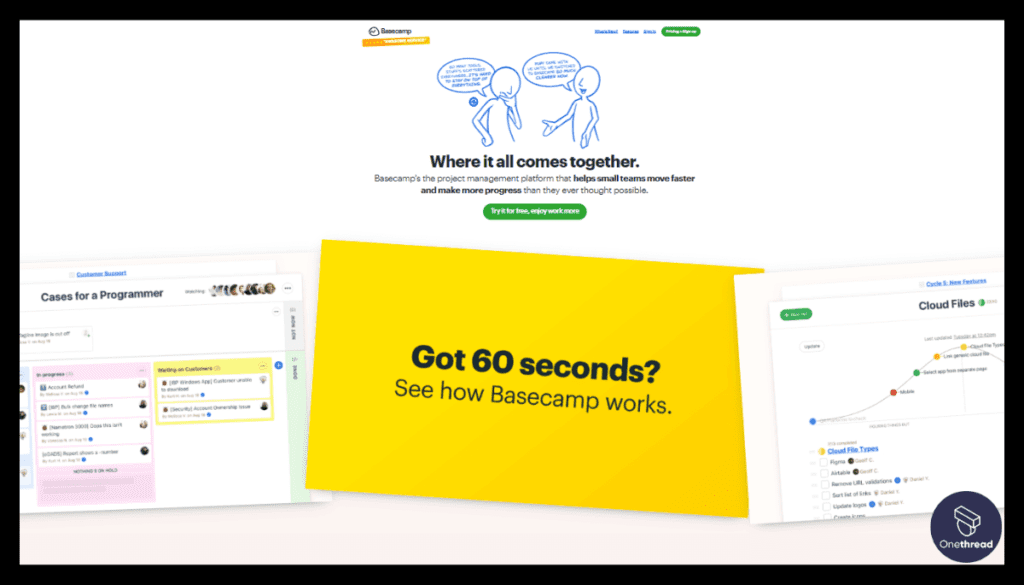
Basecamp is a renowned project management and team collaboration tool that emphasizes simplicity and usability. Founded in 2004, Basecamp’s streamlined approach to managing projects has made it a favorite among teams seeking clear communication and organization.
Its working procedure involves creating projects, assigning tasks, communicating through chat and message boards, and sharing files. The benefits of Basecamp include its user-friendly design, effective collaboration tools, and focus on maintaining a clear record of project history.
- Platforms: Available on the app (iOS, Android), website, Windows, and macOS.
- Integrations: Limited integrations compared to competitors, but connects with popular tools like Google Workspace.
- User Experience (UX): Simple, clutter-free interface with an emphasis on ease of use.
Features of Basecamp
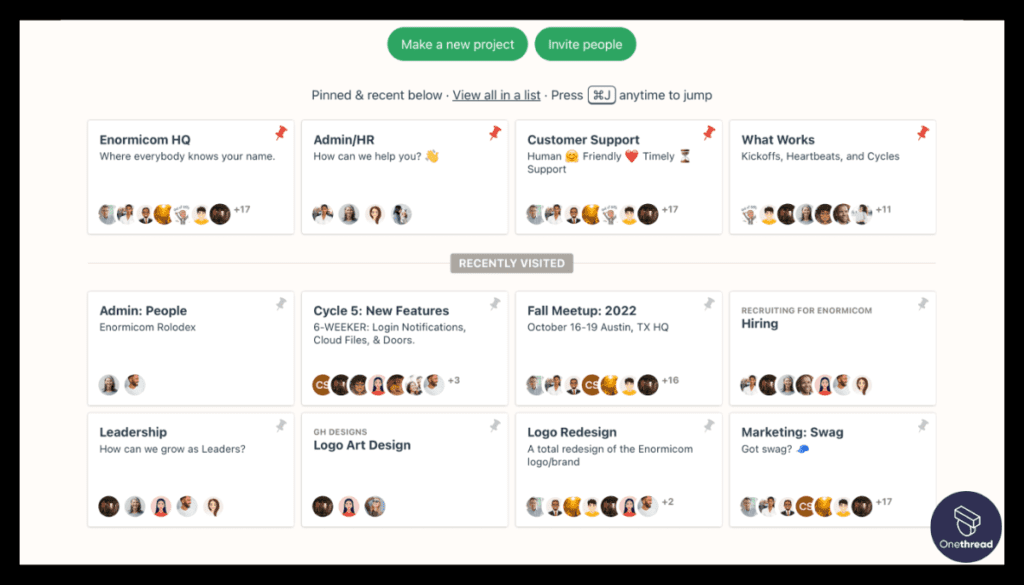
- Communication-Centric: Basecamp is designed for effective team communication, with message boards, direct messages, and real-time chats.
- To-Do Lists and Tasks: It includes to-do lists for task organization and assignment, helping teams stay on top of their work.
- Document Sharing: Basecamp allows easy sharing of files and documents, promoting collaboration and resource access.
- Calendar and Scheduling: The platform offers a calendar for scheduling events, milestones, and deadlines.
- Message Boards: Basecamp’s message boards facilitate discussions, announcements, and updates in a centralized space.
- Client Collaboration: It provides tools to collaborate with clients, share project progress, and communicate effectively.
Pros & Cons of Basecamp
Pros
- Communication-centric approach
- To-do lists and collaboration tools
- Client collaboration features
Cons
- Lacks advanced project management functionalities
Customer Ratings
- G2: 4.3 (5,442+ reviews)
- Capterra: 4.4 (13,241+ reviews)
Pricing
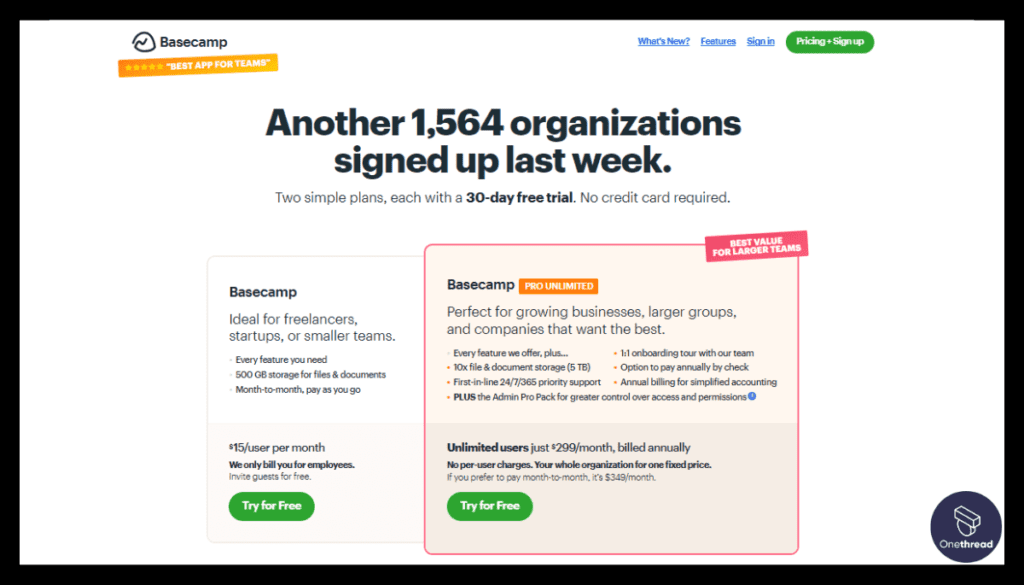
- Free trial
- $15/user/month
Is Basecamp Better than Gantt Chart?
Basecamp moves away from the traditional Gantt Chart approach, focusing instead on clear communication and organization.
While it may not provide a Gantt Chart view, its simple design can be an appealing alternative for teams looking for an uncomplicated way to manage projects.
Our Review of Basecamp
Basecamp shines in its commitment to simplicity and effective team collaboration. It’s not overloaded with features or different views but provides exactly what many teams need to keep projects on track.
Its flat pricing for unlimited users is a standout, making it a cost-effective choice for larger teams. Though lacking in Gantt Chart views and some integrations, Basecamp’s core strength lies in its straightforward approach to project management.
If your team values clear communication, ease of use, and a tool that cuts through the noise, Basecamp’s tried-and-true method might be the ideal Gantt Chart alternative for you. Its longevity in the market attests to its effectiveness and continued relevance in the evolving landscape of project management tools.
Choosing the Best Gantt Chart Alternative
When choosing the best Gantt Chart alternative, consider the following criteria:
- If you need extensive integrations, then look for tools like Monday.com.
- If ease of use is your priority, then options like Asana and Basecamp may be suitable.
- If your budget is a concern, then explore tools with free or low-cost plans like Zoho Projects.
- If you desire a comprehensive feature set, then explore Onethread or ClickUp.
Wrapping Up!
The landscape of Gantt Chart alternatives in 2023 offers diverse and powerful options, catering to different needs and preferences. Whether you’re seeking simplicity, extensive features, or a budget-friendly solution, the perfect alternative is out there. Each tool has unique strengths that might resonate with different project managers and team needs.
Among these, Onethread stands out as a robust Gantt Chart alternative. With its extensive features and user-friendly interface, it’s worth giving it a try. Experience the power of Onethread today, the perfect Gantt Chart alternative tailored for your success!
Frequently Asked Questions
What are Gantt Charts used for?
Gantt Charts are used for project planning and scheduling, visualizing tasks, timelines, and dependencies within a project.
Why look for alternatives to Gantt Charts?
Alternatives to Gantt Charts might offer improved collaboration, additional features, or a different approach to project visualization.
Is Onethread a good alternative to Gantt Charts?
Yes, Onethread is a strong alternative, offering extensive features and a user-friendly interface.
What other tools are similar to Gantt Charts?
Tools like Monday.com, Asana, and ClickUp are similar to Gantt Charts, providing project management functionalities.
Can I use a Gantt Chart alternative for free?
Yes, some alternatives like Zoho Projects and Basecamp offer free plans with limited features.
